
- Places to Visit
- Sightseeing
- Practical Tips
- Where to Stay

London Transport Zones
London is divided into 1–9 zones*, but most of it fits into zones 1–6. Central London is zone 1, zone 2 is the ring around zone 1, zone 3 is the ring around 2 and so on.
*zones 7,8 and 9 cover a small area just outside North West London including Watford, Croxley Green, Rickmansworth, Amersham or Chalfont & Latimer.
It’s important to be aware of London’s transport zones and to find out what zone a station is in. Ticket prices for One Day, Weekly or Monthly Travelcards or the money deducted from a Pay as you go Oyster card or contactless card can vary considerably according to how many zones you travel through.
The zones do not apply to bus travel . You can travel by bus all over London (zones 1–6) with any Travelcard.
First time visitor to London? See our guide to London’s transport tickets
London zone map
You can see the zones on a tube map, coloured in either white or grey.
- View a standard PDF version of the tube map
- If you stay in a part of London that is not on the tube network, see the National Rail services map (pdf) to find the zone for your closest train station.
What London transport zones do I need?
Find the closest underground or train station to your accommodation. Then find the zone of the station you want to travel to. If you’re visiting London for sightseeing or to shop this will probably be zone 1.
When you know the zones you need to pay for, what you do depends on the type of ticket/pass you buy:
Weekly or monthly Travelcards
You buy a Travelcard that covers all the zones between where you stay and where you want to visit/your regular final destination. For example:
- if you stay in Shepherd’s Bush (zone 2) and plan to visit central London (zone 1), you need a zone 1-2 Travelcard.
- If you stay in Wimbledon (zone 3) and travel to/from central London, you need a zone 1-3 Travelcard.
Pay as you go Oyster card
If you use a Pay as you go Oyster card , top-up your card with enough money to either pay for a single journey for the zones you travel through or add enough money to cover the cost of the ‘daily cap’ if you want unlimited travel for the day.
Contactless
With a contactless card, you do not have to worry about the zones as the system will calculate the fare for you the next day. Remember to always touch in and out on the tube or local trains (with the same card!) to ensure you are charged the correct amount.
How to pay for transport outside your normal transport zone
There may be occasions when you need to travel outside the zones on your weekly or monthly Travelcard.
The procedure is slightly different if you have a Travelcard loaded on an Oyster card, or a paper Travelcard:
Travelcards on an Oyster card
If you already have a weekly Travelcard for certain zones and want to visit a place outside that zone, top-up your Oyster card with some Pay as you go money to cover the cost of travelling between the last zone on your Travelcard and the zone you want to visit.
For example, if you have a zone 1-2 weekly Travelcard and you want to visit Richmond in zone 4, you need to add extra money to your Oyster to cover the fare for zones 3 and 4.
See Oyster single fares to find a fare. You can add extra money to your Oyster card at a tube station ticket machine.
Paper Travelcards
If you have a paper version of the Travelcard, you need to buy an extension ticket from the underground station ticket machine.
Stations in two zones
Some stations are on the border of two zones. These stations have a white box around their name on the tube map. Tickets to these stations are slightly different.
For example:
- Earl’s Court tube station is in zone 1/2. If you stay in Earl’s Court and take the tube to any other station in zone 1 (central London), you pay the zone 1 single fare with a pay as you go Oyster or contactless card.
- If you travel from Earl’s Court to Heathrow (zone 6), the single fare is charged from zone 2 to zone 6, not from zone 1-6.
- ABBA Arena is in zone 2/3. From zone 1, you pay the zone 1-2 fare. If you are staying in outer London and are travelling to the stadium without travelling through central London (zone 1), you pay the the fare to zone 3.
How to save money on travel to central London from zones 2-6
A major benefit of the Travelcard is that it’s valid on the buses for the whole of London, regardless of the zones you buy.
If you stay in zones 2-6 and want to travel to zone 1 (central London) a good money-saving tip is to buy a weekly or monthly Travelcard excluding zone 1 , but including zone 2. You can then take the tube/train to the zone 2 station close to zone 1 and then use the bus to travel to and around zone 1.
This only works with a weekly or monthly Travelcard, but you will save a money.
- If you stay in zone 5, a zone 1-5 weekly Travelcard is £73.00 .
- A zone 2-5 weekly Travelcard is £42.50 , saving you £30.50 a week
- A zone 1-5 monthly Travelcard is £280.40
- A zone 2-5 monthly Travelcard is £163.20 a saving of £111.70 a month
Popular places to visit outside central London (Zone 1)
Tourist attractions.
Chiswick House – zone 2 (Turnham Green) Cutty Sark – zone 2 Dulwich Picture Gallery – zone 2 Ham House – zone 4 Hampton Court Palace – zone 6 Kenwood House – zone 2 (Archway) Kew Gardens – zone 3 National Maritime Museum – zone 2 Osterley House – zone 4 RAF Museum Hendon – zone 4 William Morris Gallery – zone 3
Westfield London (Shepherd’s Bush/White City) – zone 2 Westfield Stratford – zone 2/3 Camden Market – zone 2
Sport and music venues
The O2 – zone 2/3 Twickenham Rugby Stadium – zone 5 Wembley Stadium – zone 4 Emirates Stadium – zone 2 ABBA Arena – zone 2/3 (See stations in two zones above)
Greenwich – zone 2 Richmond – zone 4 Wimbledon – zone 3
Related pages
- One Day & Weekly Travelcards including zone 1
- Weekly & monthly Travelcards excluding zone 1
- Oyster cards
- Contactless cards
- Bus tickets & passes
Last updated: 23 February 2024
Transport tickets & passes
- Guide to London's transport tickets
- One day & weekly Travelcards
- Zone 2–6 weekly Travelcards
- Bus tickets & passes
- Oyster card
- Oyster single tickets
- Oyster card refunds
- Child tickets & passes
- Local train tickets
Useful information
- Plan your journey
- London transport zones
Popular pages
- Left luggage offices
- Congestion Charge
- 2 for 1 discounts at London attractions
- Top free museums & galleries
- Cheap eating tips
- Heathrow to London by underground
Copyright 2010-2024 toptiplondon.com. All rights reserved. Contact us | Disclaimer | Privacy
Your Ultimate Guide To London Zones 1-9
Link Copied
Share on Facebook
Share on Twitter
Share on LinkedIn

Get in the zone!
London is a vast city that spans 607 square miles (or 1,572 km). Irrespective of its size, the city maintains a reliable public transportation network that connects each of the 32 London boroughs. There are several ways to get about, including the tube overground, river buses, a tram system, and even a cable car. It is expected that first-time visitors to the city could feel a little overwhelmed, but don't worry; reading the blog till the end will help you. Going forward, we're going to explore the different London zones 1 to 9, which will give you an idea of how to navigate your way through!
What are London Zones?
At resent, the London zones 1 to 9 are the most well-known. London travel zones are separated for transportation, with Zone 1 being the city centre and Zone 9 being the city's outskirts. Transport for London (TfL) uses the technology to determine a customer's journey distance and charge appropriately. Since most of London's major attractions and the city centre are located in Zone 1, most visitors won't need to venture outside. For those travelling far, it's crucial to consider how many London zones you'll pass through because this will influence the ticket you need. If you plan to travel around London as a student and are wondering what to do, our blog on student life in london can help you with a lot of insights!
What are the 9 London Zones?
Rail transportation in London is divided into London zones 1 to 9, which are being managed by London Transport. Six fare London zones are given to each station on the London Underground zones, London Overground, National Rail, TfL Rail, and Docklands Light Railway. The central core region is covered by Zone 1 , while fare zones 2, 3, 4, 5 and 6 are basically concentric circles around Zone 1. Zone 7,8 , and 9 , which extend into Buckinghamshire, Essex and Hertfordshire to include all stations served by TfL services and some Southeastern and Greater Anglia services that are outside Greater London. However, these zones do not form complete rings around London. To purchase tickets faster, zones were created to lower pricing. In addition to navigating within the city, it's important to consider transportation options for journeys beyond the city limits, such as London airport transfers . There are various platforms providing reliable and convenient transfer services, ensuring a smooth transition to or from major airports like London’s Heathrow, Gatwick, Stansted, Luton, and City Airport. Here’s a breakdown of the London zones 1 to 9 and their locations for better understanding:
Zone 1: London City Centre
The heartbeat of the city, Zone 1 encompasses iconic landmarks like Big Ben and the Tower of London, offering a blend of historical richness and modern vibrancy.
Zone 2: Notting Hill, Camden Town, London Zoo
Zone 2 is a cultural hub with the trendy streets of Notting Hill, the alternative charm of Camden Town, and the zoological wonders of London Zoo, along with two prominent football stadiums for sports enthusiasts.
Zone 3: Kew Gardens, Wimbledon and London City Airport
Embracing natural beauty, Zone 3 features the lush landscapes of Kew Gardens, the renowned Wimbledon tennis championships, and the convenience of London City Airport for quick getaways.
Zone 4: Wembley, RAF museum, Richmond Park
Zone 4 boasts the iconic Wembley Stadium, the fascinating RAF museum, and the tranquil expanses of Richmond Park, making it a diverse blend of sports, history, and nature.
Zone 5: Twickenham, England Rugby Union
A haven for rugby enthusiasts, Zone 5 is home to Twickenham Stadium, the world's largest dedicated rugby union venue, and serves as the heart of England Rugby.
Zone 6: End of the line for Central, District, Thameslink, Heathrow Express, Elizabeth, Metropolitan, Overground and Piccadilly
As the gateway to various transport networks, Zone 6 marks the termination point for multiple train lines, providing essential connectivity and convenience.
Zone 7: Zones A - Croxley, Rickmansworth and Watford and B - Chorleywood
Zone 7 encompasses charming towns like Croxley, Rickmansworth, and Watford in Zone A, and the picturesque surroundings of Chorleywood in Zone B, offering a mix of suburban tranquillity and urban accessibility.
Zone 8: Zone C - Chalfont & Latimer
Zone 8 features the serene locales of Chalfont & Latimer, providing a peaceful escape from the bustling city life.
Zone 9: Zone D - Amersham and Chesham
The outermost reaches of London, Zone 9's Amersham and Chesham offer a more rural atmosphere, showcasing historic charm and scenic beauty.
What are the types of London transport in London zones?
London is a massive city with various modes of transport, wherein everyone can travel on a budget and in comfort. The city provides London transport through buses, underground tubes, DLR, also known as Dockland Light Railways, Cable cars provided by Emirates, river buses, overground trains and the most efficient bicycles. With these many options, you can comfortably and conveniently travel within the zones in London, and also explore the city and visit the top restaurants in London .
1. The Underground
First ride : 5 am Last ride : 12 am
The London Underground Zones 1 to 9 is the oldest underground rail network and one of the best London travel zones in the world. Locals call it the "Tube" because parts of the network's tunnels resemble round tubes running through the ground. Underground stations are marked with a red and blue roundel around the city. To know more, we have a detailed blog about how to use the London underground . The Underground transport is a hallmark of public transit in London. Take a look at our webstory on public transportation in London if you're a visual learner!
2. The Overground
First ride : 5:30 am Last ride : 12:30 am
The overground, which should not be confused with the "Tube," runs above street level and connects the city centre to the larger metropolitan area using zones in London. To improve connectivity between the zones in London, it was introduced in 2007. North and West London railways had experienced serious degradation over the years. To build a complete orbital network to serve the Capital, London Overground sought to merge these older networks into new lines in east and south London, and now is one of the best London travel zones.
3. Docklands Light Railway
Unlike the rest of London's transport system, the DLR is one of the completely driverless London zones. The DLR connects with London's cable car, the Emirates Air Line, and serves the docklands neighbourhood of London zones, located directly east and southeast of Central London. Use the Light Rail to scout out the best living areas. For more information, read our blog on the 10 best neighbourhoods in London .
.webp)
4. London Buses
In addition to being a great way to view the city, buses in London travel zones have one key advantage over all other forms of London transport: they are not constrained by the "zone" system. Why does this matter? There is a set rate of £1.65 for each trip, regardless of how far or where you are going. Additionally, they benefit from the hopper fare, which allows unlimited bus rides within an hour for a fixed fee of £1.65.
5. Emirates Air Line (Cable Car)
First ride : 8 am Last ride : 8 pm
Don't be deceived by its misleading name; the UK's only urban cable car system will only take you 90 metres above London (295 feet). Enjoy stunning panoramic vistas of London zones 1-6 as it moves from Greenwich to Royal Victoria Dock—more magnificent than helpful. You can also use an Oyster travel card contactless card to make payments through the TfL system, just like you would if you were travelling by bus or train.
6. Boris Bikes
First ride : all-day Last ride : all-day
London 1-6 zones Santander Cycles, often known as 'Boris Bikes' locally, operates a public bicycle rental programme in zones in London 1-6 with more than 12,000 bicycles and 800 docking stations. Cycling around the city is a terrific (and environmentally responsible) way to explore. In the last ten years, the number of cyclists on London's roads has more than doubled.
7. River Bus
First ride : 5:30 am Last ride : 11:30 pm
The imprecisely called 'River Bus' runs 6 routes along the River Thames between Putney in the west and Woolwich in the east, departing from 22 piers. Since departures only occur every 20 minutes, we advise scheduling your trip in advance to prevent delays in travelling in London zones 1-8. The river bus is an excellent way to go around the city and enjoy fantastic views of London's riverfront and witness the scenic beauty.
Transiting in style so why not live in style in our accommodation?
Book through amber today!
What are the London zone fares?
While travelling in London, the fare you will pay depends on the zone you are travelling in. The fare is calculated according to the London zones you pass by while reaching your destination, considers your mode of transport, and covers underground buses and trains. There are also several ways to pay for your travel between London Zones 1 to 9, keep reading to know all about the different ways you can pay!
How to pay for London transport in London zones
Even though London's transport system is among the best in the world, a newcomer to the city could find it a little challenging to navigate. Oyster card , debit or credit card, and Apple or Contactless Pay. It is extremely important to keep in mind that every person requires their means of payment; otherwise, you can be charged more than you are in general.
1. Apple Pay
Apple Pay is one of the most preferred options to pay for public London transport in London zones 1 to 9 and London zones 1 to 9. Except for using your phone, this payment option is much the same as the contactless. You can tap the yellow card reader with your phone just like you would for a physical card if you have your credit or debit card set up in your Apple Pay or Google Pay wallet.
2. Oyster Cards
These convenient tiny cards make navigating the city easy when it comes to figuring out how to pay for public transport in London zones 1 to 6 or London zones 1 to 9. You can purchase them at the airport, several train stations, and many convenience stores in the city. You can top up your oyster card as many times as necessary, and they cost five pounds each. The London oyster card price is around £7 , which is the price of purchasing the card. If you use a Pay as You Go Oyster card, top it up with enough cash to either pay for a single ride across the zones you travel through or add enough cash to cover the cost of the "daily cap" if you want unrestricted travel for the day. The cost of a Zone 1–5 weekly Travelcard is £65.70 if you stay in Zone 5. A weekly Travelcard for Zones 2–5 costs £38.20 , saving you £27.50 each week. To find out more information about oyster cards, head to our blog on the ultimate guide to oyster cards .
3. Contactless Payment
Contactless payment is available for those with a credit or debit card that accepts contactless payments. Check for the "contactless" icon on the card's front (shown above) or inquire with your bank or card provider if you're unclear if your card has it.If you do have it, this is undoubtedly the simplest and most practical method for paying for London transport zones. The fare is automatically generated based on the distance you have travelled if you tap your debit/credit card on the yellow card reader at the ticket booth. To make sure that you are paying the correct fare and you are not overcharged, you should always tap it at the beginning and end of your tube ride. You simply need to tap in once on buses to begin your trip, making travelling in London zones easy for you.
4. Foreign contactless card
You may pay for transport in London with a contactless debit or credit card if you have one. If you don't have or don't want an Oyster card, it's perfect. Or if the pay-as-you-go credit on your Oyster card runs out. You tap in and out at the ticket barriers at the tube or railway station or press the yellow card reader when you board a bus to use your card like an Oyster card. The primary distinction is that the fare is deducted from your debit card or credit card the next day; you no longer need to load money onto your Oyster card.
How to save money on travel to central London zones 2-6
The London Travel card has the primary advantage of being accepted on buses across all of London, regardless of which London zones you want it for. Purchasing a weekly or monthly Travelcard that excludes London Zone 1 but includes Zone 2 is a smart money-saving move if you live in Zones 2–6 and need to travel to Zone 1 (the centre of London). Take the bus to and around Zone 1 after taking the train or tube to the Zone 2 station closest to Zone 1. You will only save some money if you use a weekly or monthly Travelcard . Have a look at these prices for better understanding:
Zone 1-5 weekly Travelcard is £69.60
Zone 2-5 weekly Travelcard is £40.50
Zone 1-5 monthly Travelcard is £267.30
Zone 2-5 monthly Travelcard is £155.60
Zone 6-9 weekly Travelcard is £64.40
Zone 6-9 monthly Travelcard is £247.30
Fares for stations in two zones
Zones 1 through 9 are the nine fare zones that make up the London public transport system. Zone 1 covers the city's centre, and the remaining zones are distributed outside. A station is said to straddle the boundary between two adjacent zones when it is located on their border. This is especially true for public transportation systems like the London Underground Zones 1 to 9 (Tube) and others where the fare you pay varies according to the zones you go through.
Stations on the border of two zones are frequently marked on the tube map with a unique graphic clue to help passengers understand their location. To be more precise, the names of certain stations on the map might have a white box around them. Because these stations are situated on the border between two fare zones, they have a particular status that makes them easy to identify for travellers. It is advised that passengers may have particular ticketing concerns when travelling to or from these border stations. This can entail different rates, ticket options, or fee computations when compared to trips that take place wholly inside one zone.
Popular places to visit outside London Zone 1
Zone 1 is a London zone which covers most of central London. However, the areas outside of Zone 1, too, are filled with tons of tourist attractions, culture, and eateries for you to explore during your stay in the capital of England. Here are some of our favourites:
1. Horniman Museum : near Forest Hill station 2. Greenwich : near Cutty Sark station 3. Highgate Cemetery : near Archway station 4. Battersea Park : near Battersea Park station 5. Oxleas Wood & Sever nDroog Castle: near Eltham station 6. Brockwell Lido : near Herne Hill station 7. Broadway Market : near London Fields station 8. London Wetland Centre : near Barnes station 9. Bruce Castle Museum : near Bruce Grove station 10. Crystal Palace Park : near Crystal Palace station
You are all set to venture around London through the London zones 1-9! We hope our London zones guide will help you navigate the city easily and comfortably as a new traveller in the country. Remember to follow all the laws of the country, and don't forget to tap in and tap out to avoid any penalties on your travel cards. If you're a student planning to study in the UK, finding suitable accommodation might be a concern. Explore the amazing student accommodation options in the UK and start your journey today!
Frequently Asked Questions
How many london zones are there in the city, is an oyster card cheaper than a travelcard to travel through the zones in london, in which of the london zones 1 to 9 does the london city centre lie, how much does it approximately cost to travel in london zones 1 to 6 or london zones 1 to 9, 5. what are some popular tourist attractions in london travel zones outside of zone 1.
Your ideal student home & a flight ticket awaits
Follow us on :

Related Posts
.jpg)
Safe Havens: Explore 20 Safest Places to Live in the US!

Master the Guide of Cost of Living in Berlin- 2024

8 LinkedIn Profile Tips For Job Seekers

Planning to Study Abroad ?

Your ideal student accommodation is a few steps away! Please fill in your details below so we can find you a new home!
We have got your response

amber © 2024. All rights reserved.
4.8/5 on Trustpilot
Rated as "Excellent" • 4800+ Reviews by students

Rated as "Excellent" • 4700+ Reviews by Students
amber © 2023. All rights reserved.

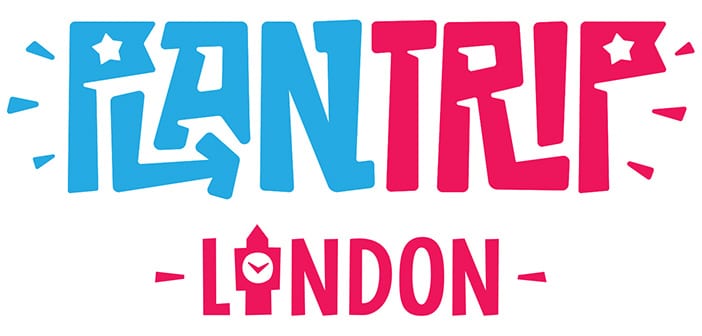
London Travel Zones
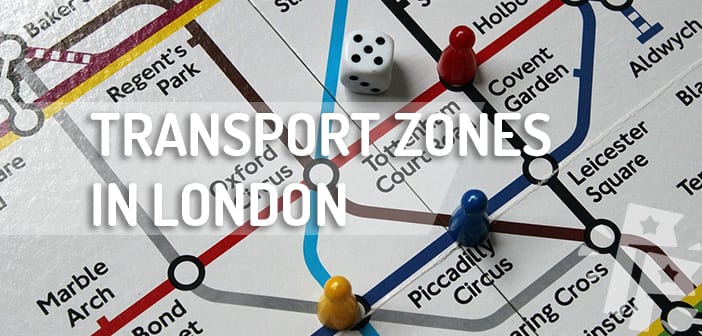
London is divided into travel zones which determine the price of travel on public transport across the city. Therefore, it’s good to understand the London travel zones so you know which Travelcard you need to buy, and it’s a particularly important consideration when choosing where to stay in London. The further your accommodation is from the city centre, the more expensive it will be to travel into the city daily to visit tourist attractions and places of interest.
London is divided into nine radial zones. Looking at the London Underground tube map, you can see that zone 1 is the centre of London, with zones 2-9 extending out in a circle around it.
What to bear in mind about London travel zones when planning a trip to London
Tourist attractions.
Most of London’s most famous tourist attractions are located in the city centre within London’s transport zone one. Here you will find some of the most iconic places of the British capital, including Oxford Street, Regent Street, Piccadilly Circus, Covent Garden, Trafalgar Square, the London Eye, Big Ben, most of London´s top museums and West-End Musicals .
Some of London´s most famous neighbourhoods are also located in zone 1, such as Notting Hill , Chelsea and Kensington.
The most visited tourist attraction outside of zone 1 in London is probably Camden Market which is located in zone 2.
To travel between zones 1 and 9 on public transport, including underground, overground, DLR, buses, trams and trains and even some riverboat services, you can use one of London´s transport cards, such as the Oyster Card or a London Travelcard , or you can even use a contactless debit or credit card.
Stansted and Luton airports are located outside of the London transport zones, so it’s necessary to buy a specific train or bus ticket to get to and from these airports. You can´t use your oyster card or travelcard for these journeys.
Gatwick Airport is also located outside of London, but you can use an Oyster card or contactless payment to travel from Gatwick Airport to London and vice versa.
Heathrow and London City airports are both located within the London travel zones. Therefore, to travel to and from these two airports, you can use Contactless, Oyster Card or Travelcard .
London Travel Zones Map
The best thing to do is look at London´s Tube Map before you travel to London, to familiarise yourself with it. You can find this here: London TFL Tube Map . You will be able to see the different travel zones outlined in this map easily.
What area to stay in when visiting London
If you’re planning a trip to London, the closer you stay to the centre of London, the cheaper your transport costs will be each day, and the less time you’ll spend travelling by underground or bus. Therefore, we highly recommend looking for hotels within London travel zones 1 or 2. You can find more detailed information on where to stay in London here , as well as some recommended hotels within zones 1 or 2.
What areas to look at when deciding to live in London
If you are looking for a place to live in London, it’s often a good idea to take into account the area that you work in. The less distance and zones that you have to commute through each day, the less time and money you’ll spend on travel.
That said, it’s pretty expensive to live in zone 1 of London, so it’s normal to live outside the city centre. We recommend looking at zones 2 and 3 where accommodation is more affordable, yet you can quickly travel into the centre of London on the tube.
Related Posts
London underground, travelling in london with kids, contactless payment on london transport, london oyster card.
Save my name, email, and website in this browser for the next time I comment.
Notify me via e-mail if anyone answers my comment.
Type above and press Enter to search. Press Esc to cancel.
Winterville
London Zones Explained | A Guide to London Fare Zone Stations, Maps, Prices, and More
October 11, 2022
Winterville Staff
London is the largest city in the United Kingdom by area and population. It is home to more than nine million people living in its 607 sq mi total area.
Even though London is the largest city, the commute is effortless and convenient thanks to its efficient wide network of public transportation .
Not to mention it offers several payment options such as Pay as you go Cards, Contactless devices, and Travelcards . But before buying any of the mentioned payment cards, you need to know first about the Fare Zones.
London has divided its transportation stations into several Zones in all 32 London boroughs .
What is the purpose of Fare Zones? Simple, to compute your total fare according to your journey’s distance based on the zones you traveled to.
Fare Zones are applied to Tube , DLR , Elizabeth Line , London Overground , River Bus , and most National Rail services.
Buses and trams don’t use Fare Zones since there is already a standard fare set.
Before you hop on the iconic red London buses , fly through the skies with Emirates Cable Car , cruise the river with River Bus , or ride the London Underground , learn about the Fare Zones and which stations and routes are covered.
In this article, you will know about:
How Many Zones in London
What are the zones in london, london zone map, london fare zone rates, maximum journey time per zone, zones 1 to 6 popular tourist attractions, final thoughts.
- 1 How Many Zones in London
- 2.1.1 Fare Zone 1 Stations
- 2.2.1 Fare Zone 2 Stations
- 2.3.1 Fare Zone 3 Stations
- 2.4.1 Fare Zone 4 Stations
- 2.5.1 Fare Zone 5 Stations
- 2.6.1 Fare Zone 6 Stations
- 2.7.1 Fare Zone 7 Stations
- 2.8.1 Fare Zone 8 Stations
- 2.9.1 Fare Zone 9 Stations
- 2.10 River Bus London Zones and Piers
- 3 London Zone Map
- 4.1 Pay as you go Caps and Travelcard Adult Rates
- 4.2 Oyster Photocard Caps and Travelcard Child Rates
- 4.3 Disabled Persons Railcard Caps and Travelcard Rates
- 4.4.1 River Bus London One-Way and Round Trip Prices Table
- 4.4.2 Paper Ticket Prices at Piers of River Bus London
- 5 Maximum Journey Time per Zone
- 6.1.1 Big Ben
- 6.1.2 Palace of Westminster
- 6.1.3 Tower of London
- 6.1.4 London Eye
- 6.1.5 Madame Tussauds
- 6.2.1 Chiswick House
- 6.2.2 Cutty Sark
- 6.2.3 Dulwich Picture Gallery
- 6.2.4 Kenwood House
- 6.2.5 National Maritime Museum
- 6.3.1 Royal Botanic Gardens, Kew Gardens
- 6.3.2 William Morris Gallery
- 6.3.3 The O2
- 6.3.4 Westfield Stratford City
- 6.3.5 ABBA Arena
- 6.4.1 Ham House
- 6.4.2 Osterley Park and House
- 6.4.3 Royal Air Force Museum London
- 6.4.4 Wembley Stadium
- 6.5.1 Twickenham Stadium
- 6.6.1 Hampton Court Palace
- 7 Final Thoughts
London is divided into nine Fare Zones that are used by Tube , DLR , Elizabeth Line , London Overground , and most National Rail services. The nine Zones are as follows:
If you are traveling by River Bus , the Zones are categorized into West Zone, Central Zone, and East Zone.
What are Zones 1 to 6 in London? Zones 1 to 6 have the most famous attractions in London, of which Zones 1 and 2 are the most touristy.
Zone 1 is the city center and is home to the most popular landmarks, including the Tower of London, the London Eye, and Big Ben.
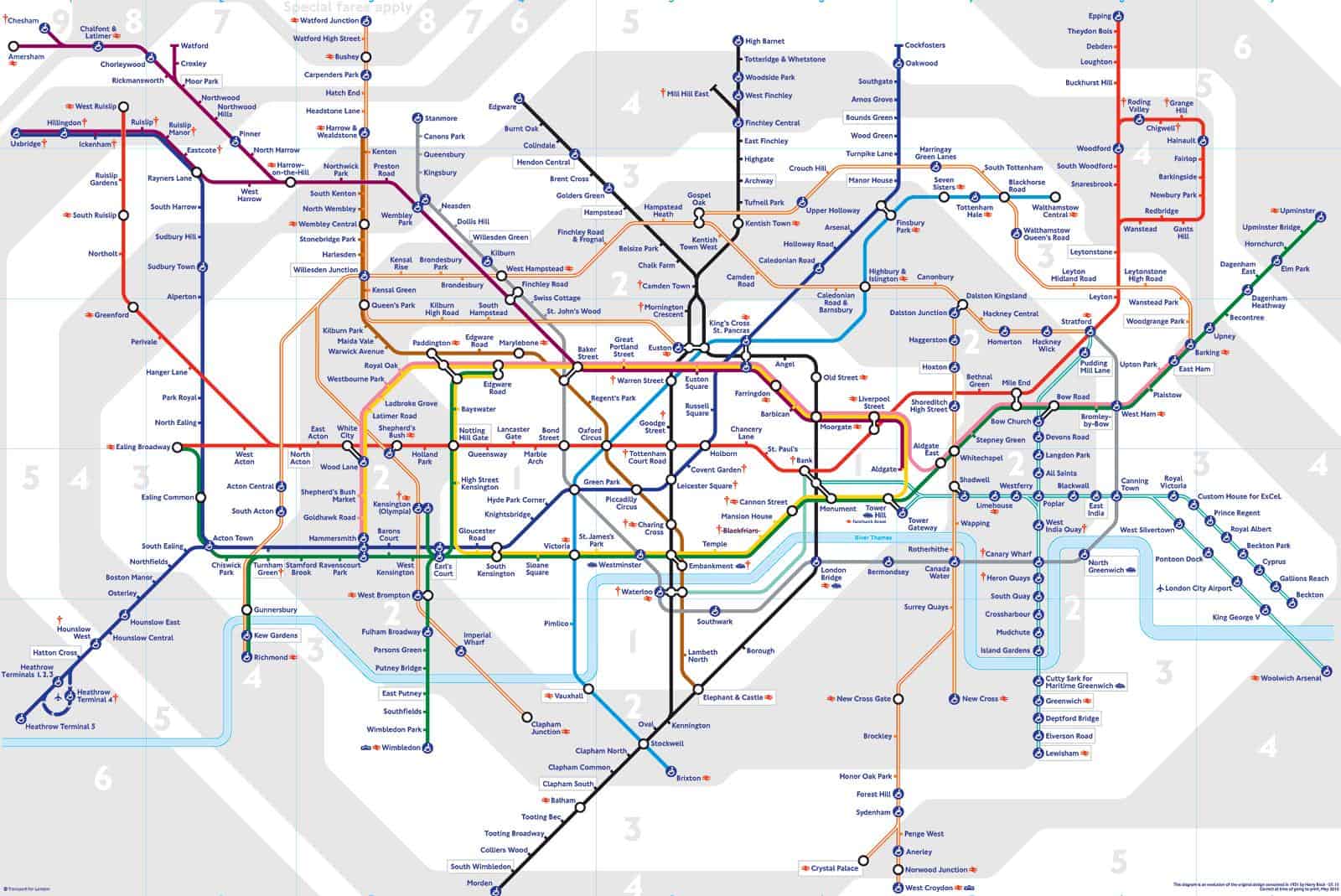
Look at the map, you can see the zones between grey and white colours.
Some tourists venture further to Zone 2 for its trendy areas such as Notting Hill , Arsenal FC Stadium, Chelsea FC Stadium, and London Zoo.
Zone 6 is one of the most traveled zones, not because of attractions but for its Heathrow Airport . As for Zones 7 to 9, these are considered to be the outskirts of the city and usually do not have many attractions to explore.
Let’s dive deeper into the nine Fare Zones and know which stations and places of interest there are in each zone.
Read more about the London Underground Map .
Fare Zone 1
Zone 1 is used by c2c, Chiltern Railways, Docklands Light Railway , London Overground , London Underground , Network Rail, South Western Railway, Southeastern, and Thameslink.
It is the central zone that has the most main tourist attractions, covering major areas such as the City of London, London Bridge, Waterloo, Paddington, Kensington, and West End, to name a few.
Fare Zone 1 Stations
Fare zone 2.
Zone 2 covers areas in the inner zone such as Notting Hill , Regents Park, Camden, and Shoreditch.
It has stations of c2c, Docklands Light Railway , Elizabeth line , Great Northern, London Overground , London Underground , Network Rail, South Western Railway, Southeastern, Southern, and Thameslink.
From Piccadilly Circus, the range of Zone 2 spans up to about five miles.
Fare Zone 2 Stations
Fare zone 3.
Zone 3 covers the areas of Kew Gardens, Wimbledon, Greenwich, London City Airport, Hampstead, Horniman Museum, and Olympic Park. It stretches up to almost eight miles from Piccadilly Circus.
Some stations of Docklands Light Railway , Elizabeth line , Great Northern, Greater Anglia, London Overground , London Underground , South Western Railway, and Southeastern are within the zone.
Fare Zone 3 Stations
Fare zone 4.
Zone 4 is included in the outer zones of the London Fare Zone. It is where you will find Richmond Park, Wembley Stadium, and RAF Museum. The coverage reaches up to about 10 miles from Piccadilly Circus.
Fare Zone 4 Stations
Fare zone 5.
Zone 5 is known for Twickenham, home to the Twickenham Stadium and the England Rugby Football Union.
It is a suburban district filled with 18th Century architecture. The area is about 12 miles southwest of Central London.
Fare Zone 5 Stations
Fare zone 6.
Zone 6 is the outer region of the Fare Zone and covers some of the end stations of several lines such as the Central line , District line , Thameslink, Heathrow Express, Elizabeth line , Metropolitan line , Piccadilly line , and London Overground .
It is widely used for journeys going to and coming from Heathrow Terminals 2 and 3 , Heathrow Terminal 4, and Heathrow Terminal 5. The area is about 16 miles from Piccadilly Circus.
Fare Zone 6 Stations
Fare zone 7.
Zone 7 covers a few stations of Northern London for Greater Anglia, London Overground , and the Metropolitan line of the London Underground .
The home county Hertfordshire is within the zone, which is bordered by Greater London to its south.
Fare Zone 7 Stations
Fare zone 8.
Zone 8 contains Cheshunt station, the terminal station of London Overground . It also has one station on the London Underground , Chalfont & Latimer station. There are no major tourist attractions in this Zone.
However, you can visit the Harry Potter Studio or the Warner Bros. Studio Tour when you go beyond Watford Junction station, a station already within the Outside Fare Zone and after the Watford High Street station of Zone 8.
Fare Zone 8 Stations
Fare zone 9.
Zone 9 covers the end stations of the Metropolitan line, the Chesham and Amersham stations. It also contains Brentwood station on the Elizabeth line . There are no major tourist attractions within the zone.
Fare Zone 9 Stations
River bus london zones and piers.
Although you may find the piers on the Tube and Rail map, the River Bus uses its own zones to calculate the fare.
You can read more information about the River Bus piers with the guide Cruise London Sights with River Bus London .
What London Zone am I in? To answer this question, you can access and download detailed maps of London transportation stations and zones provided by the Transport of London (TfL).
See more about London zone map .
When you look at the Tube and Rail map , you will see the numbered gray and white zones which indicate the Fare Zones 1 to 9. Alternatively, you can also check the list of stations outlined above to see your current station’s zone number.
Check the maps below to see which zones the stations are in. It includes the London Zones 1-6 map and Zones 7-9 map.
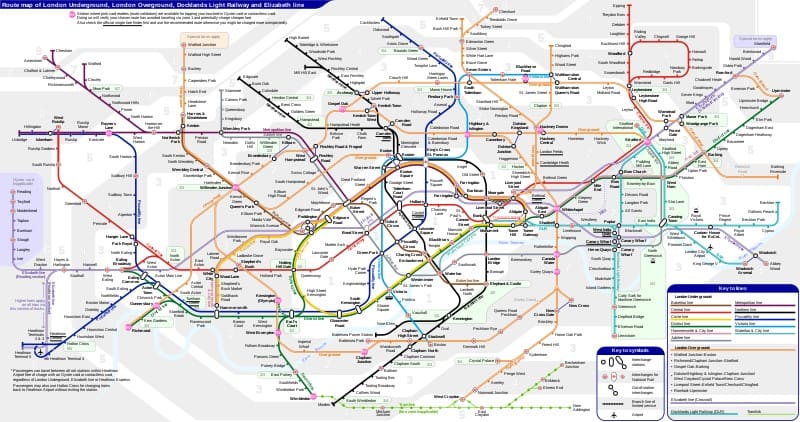
(London Zones 1 9 Map by Sameboat via Wikimedia Commons )
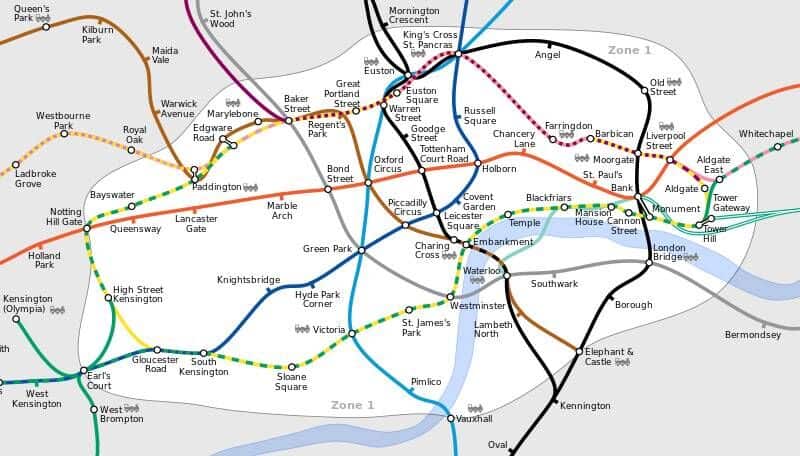
(London Underground Zone 1 by Edg2s via Wikimedia Commons )
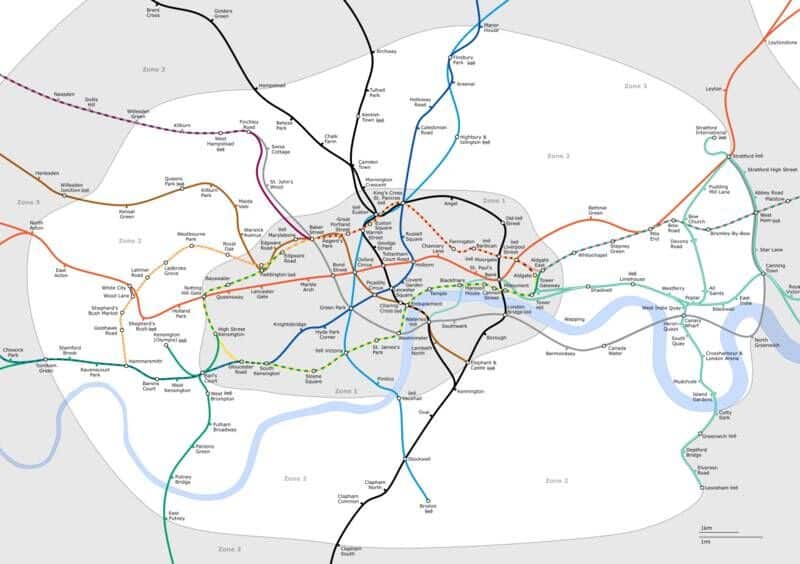
(London Underground Zone 2 by Edg2s via Wikimedia Commons )
Now that you know about the London Zones, you can now calculate the fare you have to pay.
Basically, the more zones you travel to, the higher the fare. The rates vary according to the type of payment option and journey times.
You can pay for your fare with Pay as you go cards such as Oyster Card , Visitor Oyster Card , and Contactless Card , or with a Travelcard .
If you do not have any of the mentioned payment cards, you can still purchase a paper ticket but for a higher price. Please note buses in London only accept cashless payments.
To know about the pros and cons of each card, read the guide Visitor Oyster Card Vs Oyster Card Vs Travel Card Vs Contactless Card .
Know about the single fare costs using the Single fare finder tool by selecting your start and end stations and the passenger type.
Alternatively, you can also search the fare cost by selecting the start and end zones using the Caps and Travelcard prices tool.
If you are traveling to a station located in two zones such as Abbey Road (2 & 3) or Hoxton (1 & 2) stations, the zone with the cheaper price is what you usually pay for.
How much is a London Travelcard All Zones? It depends on the number of zones included and the type of Travelcard.
You can add or reduce zones on your Travelcard and choose between a Day Anytime (£25.70), Day Off-peak (£15.30), 7 Day (£100.20), Monthly (£384.80), and Annual Travelcard (£4,008).
When you use a Pay as you go card, you have the option to put a cap or limit per day or week and select the number of zones you wish to add.
Check the tables below to see a complete list of fare rates per zone, payment card, and passenger type.
Pay as you go Caps and Travelcard Adult Rates
The cost applies to Tube , DLR , Elizabeth line , London Overground , and most National Rail services.
It does not apply to journeys made on the Southeastern high-speed trains and Heathrow Express services.
Oyster Photocard Caps and Travelcard Child Rates
Children between 5 to 10 years old with a 5-10 Zip Oyster photocard travel for free.
Children between 11 to 15 years old with an 11-15 Zip Oyster photocard , 16+ years old with a 16+ Zip Oyster photocard , and students above 18 years old with an 18+ Student Oyster photocard get discounted rates.
Disabled Persons Railcard Caps and Travelcard Rates
Disabled persons have discounted fares for both Pay as you go and Travelcards in all nine zones.
Check the complete list of Tube and rail fares to learn more about discounted rates for other passenger types.
River Bus London Prices and Tickets
Once you obtain a Pay as you go card or a Travelcard , you will have to pay another different fare for the West, Central, and East Zones of River Bus .
For instance, although you can have unlimited journeys for a fixed price with a Travelcard , you can only get a 33% discount for a one-way or roundtrip River Bus ticket.
Similar to Tube and rail, the paper ticket standard prices are also more expensive than Pay as you go or Travelcard rates.
For more information on tickets, you can also refer to Uber Boat by Thames Clippers ticket page .
River Bus London One-Way and Round Trip Prices Table
Paper ticket prices at piers of river bus london.
Despite the standard fares set, keep in mind that you need to travel within the maximum journey time per zone to avoid paying for two maximum fares.
You may be charged a maximum fare of £8.90 in Zones 1 to 9 or up to £26.00 for journeys Outside Fare Zones and on the Heathrow Express.
If you exceed the maximum journey time on a single journey, wait for at least two days to get an automatic refund or up to eight weeks to claim a maximum fare refund online.
Take note that you can only claim up to three maximum fare refunds in a month. The maximum journey time varies on the day of the week, zone, and time of the day. Check the table below to learn more.
If you plan to travel across Zones 1 to 6, here are some areas of interest to visit. You can make the most of the zones included in your card by traveling to the popular tourist attractions listed below.
在 Instagram 查看这篇帖子 UK Parliament (@ukparliament) 分享的帖子
Address: London SW1A 0AA, United Kingdom
Phone: +44 20 7219 4272
Visit Website
Palace of Westminster
Phone: +44 20 7219 3000
Tower of London
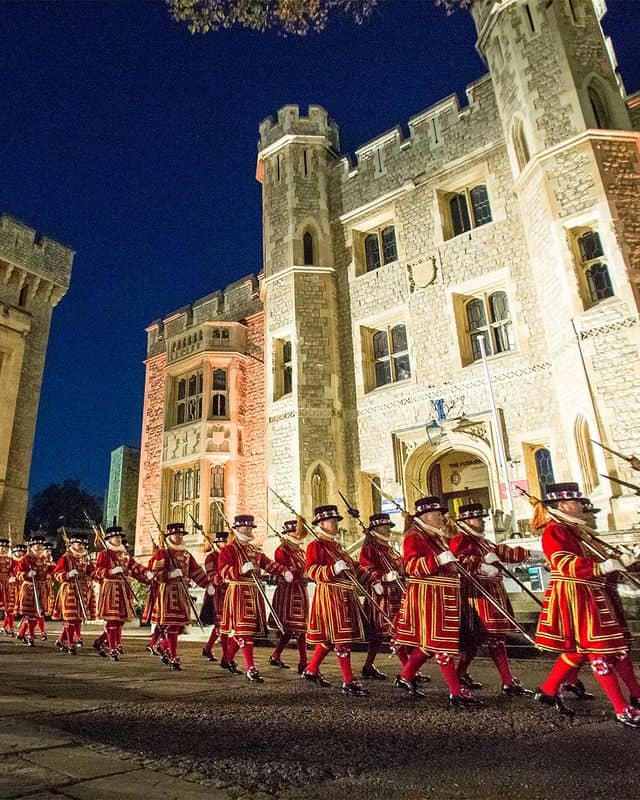
Address: London EC3N 4AB, United Kingdom
Phone: +44 20 3166 6000
在 Instagram 查看这篇帖子 The lastminute.com London Eye (@londoneye) 分享的帖子
Address: Riverside Building, County Hall, London SE1 7PB, United Kingdom
Phone: +44 20 7967 8021
Madame Tussauds
在 Instagram 查看这篇帖子 Madame Tussauds London (@madametussauds) 分享的帖子
Address: Marylebone Rd, London NW1 5LR, United Kingdom
Phone: +44 871 894 3000
Chiswick House
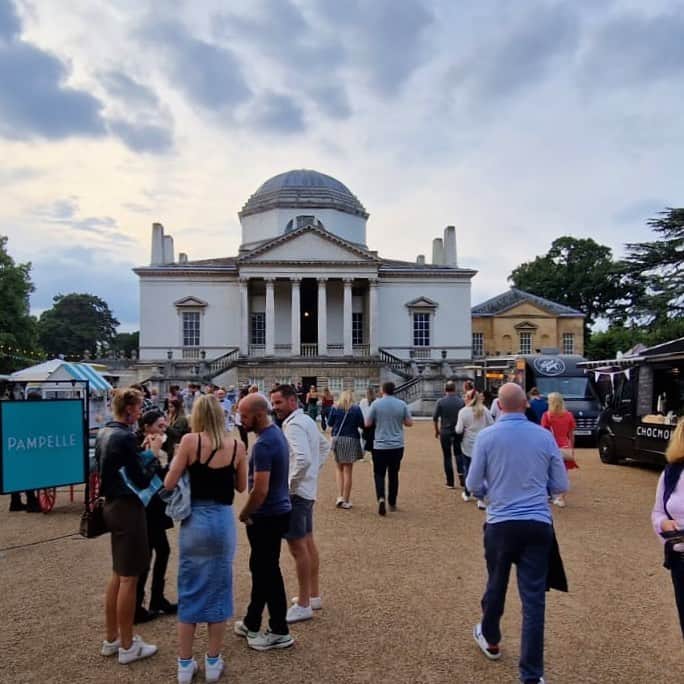
Address: Chiswick House & Gardens, Burlington Lane, Chiswick London W4 2RP
Phone: +44 020 3141 3350
Address: King William Walk, London SE10 9HT, United Kingdom
Phone: +44 20 8858 4422
Dulwich Picture Gallery
在 Instagram 查看这篇帖子 Dulwich Picture Gallery (@dulwichgallery) 分享的帖子
Address: Gallery Rd, London SE21 7AD, United Kingdom
Phone: +44 20 8693 5254
Kenwood House
Address: Hampstead Ln, London NW3 7JR, United Kingdom
Phone: +44 370 333 1181
National Maritime Museum
Address: Romney Rd, London SE10 9NF, United Kingdom
Royal Botanic Gardens, Kew Gardens
在 Instagram 查看这篇帖子 Kew Gardens (@kewgardens) 分享的帖子
Address: Richmond, United Kingdom
Phone: +44 20 8332 5655
William Morris Gallery
Address: Lloyd Park, 531 Forest Rd, London E17 4PP, United Kingdom
Phone: +44 20 8496 4390
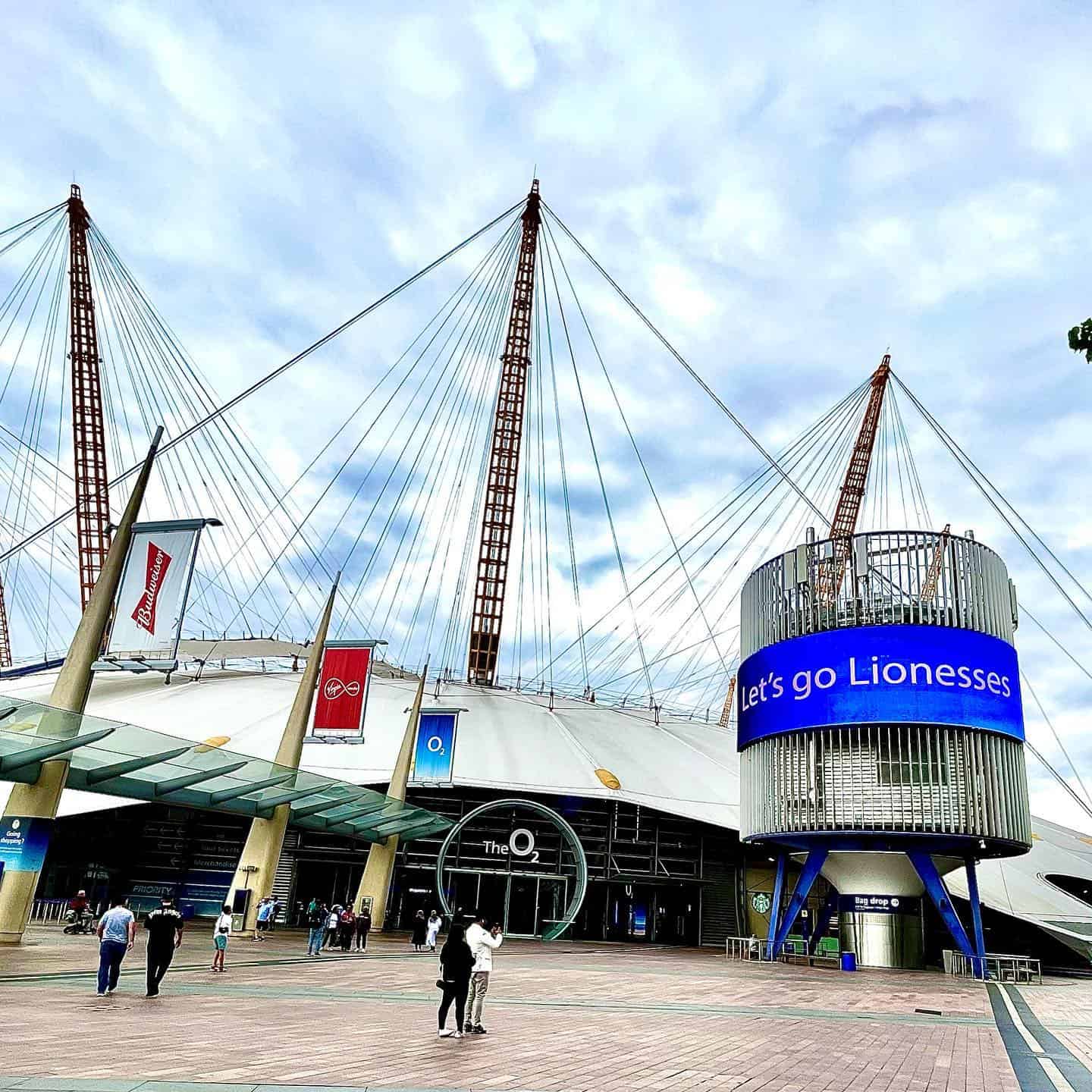
Address: Peninsula Square, London SE10 0DX, United Kingdom
Phone: +44 20 8463 2000
Westfield Stratford City
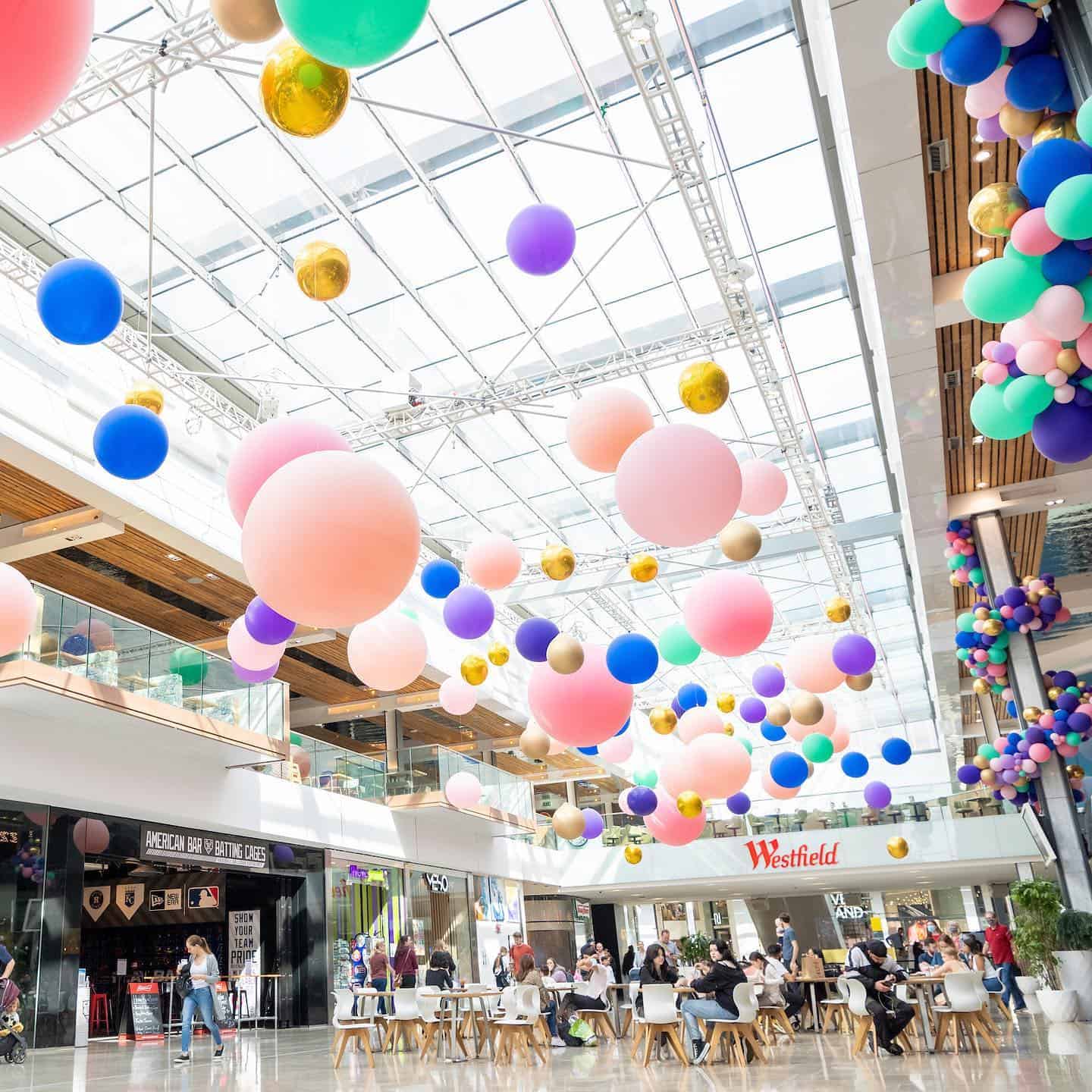
Address: Montfichet Rd, London E20 1EJ, United Kingdom
Phone: +44 20 8221 7300
Address: 1 Pudding Mill Ln, London E15 2RU, United Kingdom
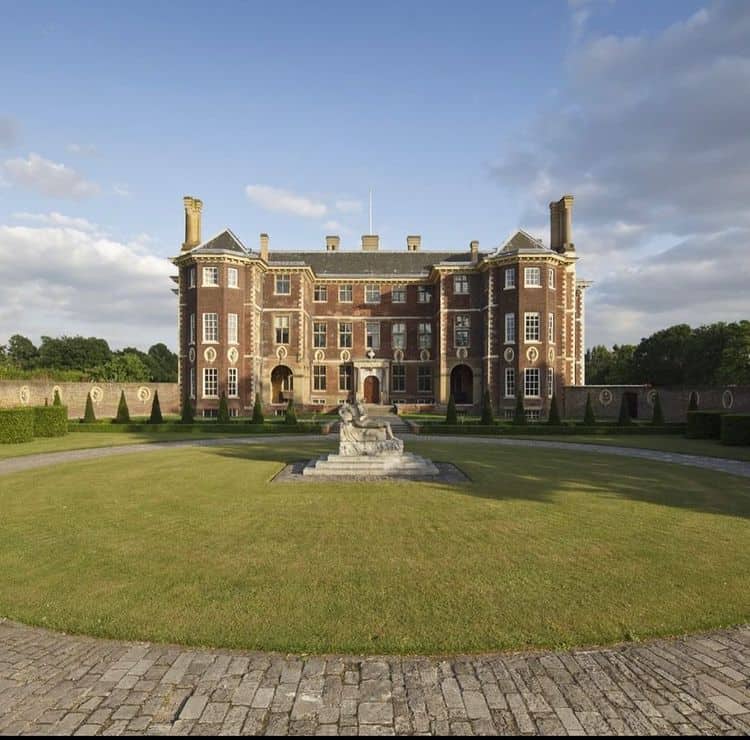
Address: Ham St, Ham, Richmond TW10 7RS, United Kingdom
Phone: +44 20 8940 1950
Osterley Park and House
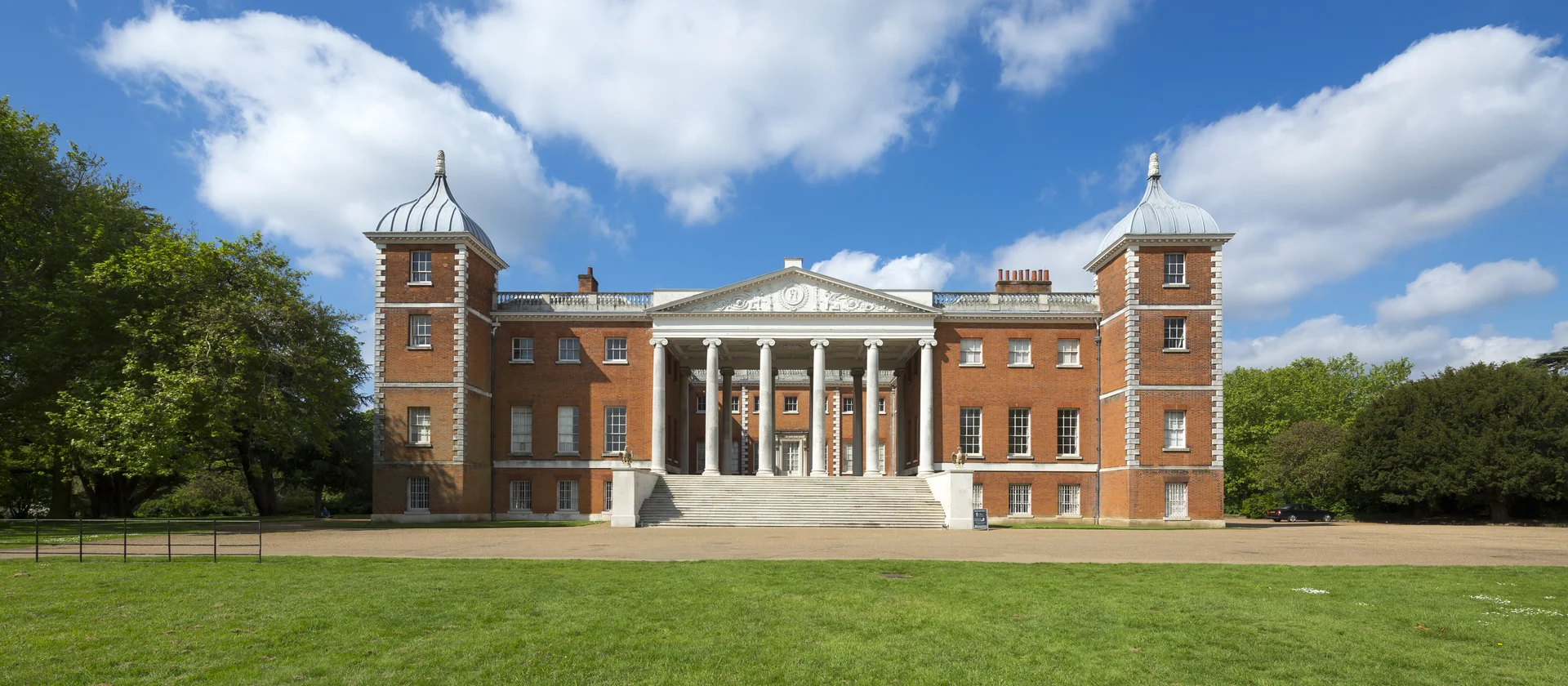
Address: Isleworth in the London Borough of Hounslow
Royal Air Force Museum London
Address: Grahame Park Way, London NW9 5LL, United Kingdom
Phone: +44 20 8205 2266
Wembley Stadium
在 Instagram 查看这篇帖子 Wembley Stadium (@wembleystadium) 分享的帖子
Address: London HA9 0WS, United Kingdom
Phone: +44 800 169 9933
Twickenham Stadium
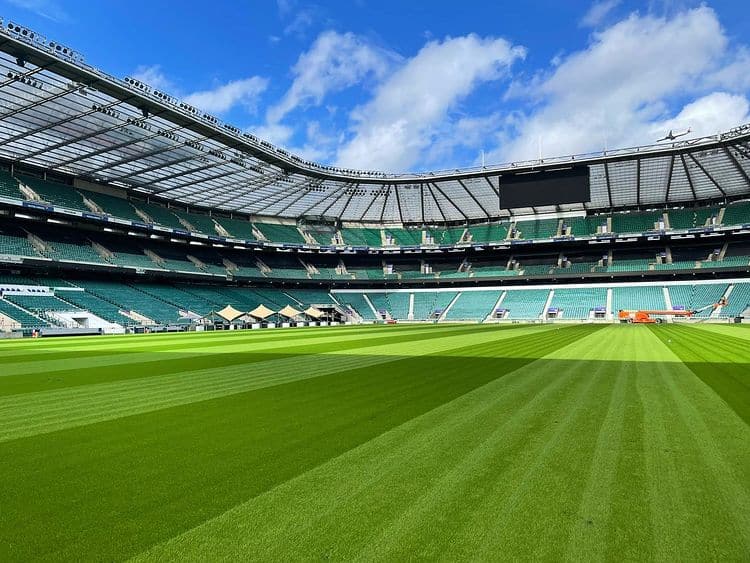
Address: 200 Whitton Rd, Twickenham TW2 7BA, United Kingdom
Phone: +44 20 3613 2036
Hampton Court Palace

Address: Hampton Ct Way, Molesey, East Molesey KT8 9AU, United Kingdom
Before buying a payment card, take note of the places you want to visit in London and list down its zone.
With that in mind, you can already have an idea of the flow of your journey and the estimated cost of the fare.
Remember, follow the correct Touching in and out method per transportation to avoid penalty charges or paying the maximum fare.
What do you think about the London Fare Zones? Do you have any tips or recommendations for fellow travelers as well? Share them below in the comments section.
You May Also Love From Winterville.co.uk

7 Top Shooting Ranges in London for Gun Enthusiasts (Updated 2023)
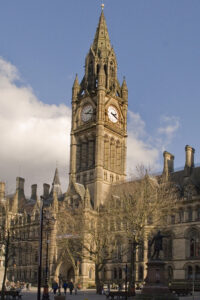
Uncovering The Best Places To Live In Manchester Uk | Where Are Safest And Dangerous Areas In Manchester?
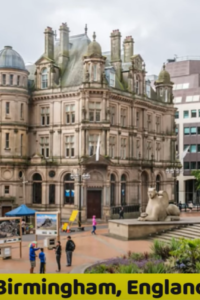
Find the Best Place to Live in Birmingham UK | Dangerous Areas and Safe Areas In Birmingham, Schools, Job Opportunities, and More!
Leave a Comment Cancel reply
Save my name, email, and website in this browser for the next time I comment.
This website uses cookies to improve your browsing experience and analyze the use of the website. Learn More

How to Use the London Tube (Subway)

This post is a quick and easy tutorial on how to navigate the London Underground (a.k.a. the Tube), including hours of operation as well as info on Oyster Cards, transfers, and other helpful tips.
- What is the London Underground?
- Tickets, Fares, and Oyster Cards
- The Tube Map
- Operating Hours
- Tips from Locals
- to/from Heathrow Airport
- Tourist Buses vs. the Tube
WHAT IS THE LONDON UNDERGROUND?
Similar to the New York Subway or the Paris Metro, the London Underground is London's series of (largely) underground trains that run a regular service throughout the city.
Since the trains underground run through a series of tunnels, many people (Londoners and visitors alike!) refer to it as the "tube."
Despite this name, a lot of the London Underground network is above ground when you travel, particularly outside of central London.

The London Underground has 11 lines that serve Greater London, intersecting with each other in the centre of town.
The tube map is divided into nine zones, with Zone 1 being the centre of London, and Zone 9 being the suburbs.
The cost it takes to travel depends on which zone(s) you travel in, and how far your journey will take you.
It also connects to the London Overground (a suburban train line that doesn't run through the centre of town), the new Elizabeth Line (a high-frequency rail service that covers both central London, Heathrow Airport, and the suburbs), and National Rail Services (standard train lines that run throughout the country).
The Underground also connects to other rail services that serve the capital such as the Docklands Light Railway (an aboveground small train line that serves the docklands area).
WHEN DOES THE UNDERGROUND RUN?
In general, the Underground trains run from around 5:00 - 5:30 am until the last train leaves around Midnight, (exact times will vary and are listed on the Transport for London website ).
However, there are Night Tube services that run on some of the lines on Fridays and Saturdays for convenient travel on the weekends.
The Night Tube runs on parts of the Central, Jubilee, Northern, Piccadilly, and Victoria lines only.
LONDON UNDERGROUND TICKETS AND OYSTER CARDS
Buying a ticket for the London Underground is pretty straightforward, but for most visitors, using a contactless payment card is the best payment method.
So, for a more in-depth explanation, including the cheapest ways to travel, check out our previous post about ticket prices and options here in London. Below is our summary.
There are 4 ways to pay for your rides on the Tube:
- Paper tickets
- Oyster Cards
- Contactless Credit/Debit Cards
We normally recommend avoiding paper tickets and recommend that you buy yourself an Oyster card, unless you have a contactless credit or debit card.
Rides with an Oyster Card or contactless card are much cheaper than paper tickets.
You can add as much money to these as you wish and there is a daily limit that you will spend, (£8.10 for Zones 1-2) so the rides get cheaper the more you use them. The same daily cap applies to your contactless card, too.
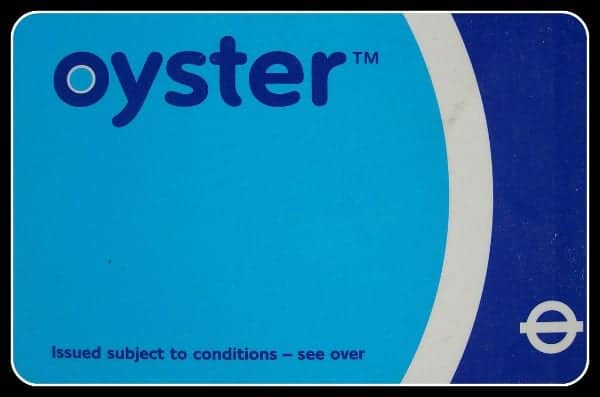
Read our post on which London Oyster Card or Travelcard to buy .
TIP: The Oyster Card is actually included with the London Turbo Pass at no extra cost. If you're planning to visit several notable attractions in the city, this could be a great way to save some money.
London Underground Fares
While there are 6 travel zones for the London Underground, most visitors to London will travel largely within Zones 1 + 2.
How much you pay depends on when you travel, whether during peak hours (06:30 - 09:30 and 16:00 - 19:00 Mon-Fri) vs. off-peak (all other times).
It also depends on where you travel to and from, and whether you are using a paper ticket vs. an Oyster, Travelcard, or contactless credit/debit card.
If you have one of the latter, then you will pay somewhere between £2.70 and £3.00 per ride within Zones 1 + 2.
The most expensive ride (Central London to Heathrow) will cost either £3.30 (off-peak) or £5.60 (peak).
Oyster and Travelcards can be used on all of London's public transportation options, including buses, DLR, the Overground, suburban trains (within London), a water taxi, and even a gondola.
Daily Limits
If you use an Oyster Card or a Contactless Card, then there are daily limits to what you will spend. These caps are dependent on where you are traveling within.
So, for example, if you stay within Zones 1 and 2, the cap for an adult is just £8.10 for the Underground and £5.25 for buses.
So, the more you ride, the cheaper each ride is. You can see what the cap is for each zone or between zones here.
Child Discounts
Children under 11 travel for free and there is a 50% discount on Oyster Card fares for children 11-15 years of age.
To receive this discount, you need to grab a Tube staff member at any Underground station, including Heathrow.
We help you determine which type of card or ticket you need in our in-depth post on Oyster Cards .
Travelcards
Travelcards are prepaid cards that give you unlimited access to specific zones within London.
You can choose to either order these in advance (in which case you will be given a paper Travelcard) or you can buy them upon arrival (in which case you will be using a plastic Oyster Card with the Travel Card loaded onto it).
Travelcards particularly have benefits for travellers here for an entire week. A 7-Day Travelcard can be worth your while, as a 7-Day Travelcard for Zones 1-2 is £40.70 which works out less per day than the £8.10 daily cap.
Find out more on our post comparing Oyster Cards, Visitor Oyster Cards and Travelcards .
UNDERSTANDING THE TUBE MAP
Picking up a Tube map is easy! They are available for free at most stations on the Underground network.
The maps on offer at the stations are small – perfect for carrying around in your pocket.
Below is a map of the London Underground. You could also download a PDF version .

Don’t be embarrassed to consult your map as you travel through London, even Londoners themselves occasionally need to check where it is they are heading to!
Some people will actually have an app on their phone sporting the London Underground tube map – though we think Google Maps App is very good.
If you look closely at the map, you will notice that the center part is shaded white (zone 1) with a ring of gray shade (zone 2) which is also surrounded by white again (zone 3).
Again, most visitors to London will spend much, if not all, of their time in Zones 1-2.
Focus on Colours
Every line on the London Underground has a different name and colour.
The names and colours will appear on your Tube Map, and also all over the various stations on the network.
For some, memorising the names is easier, but in general, colours can be the simplest way to learn your way around, and also to use when asking for/receiving directions.
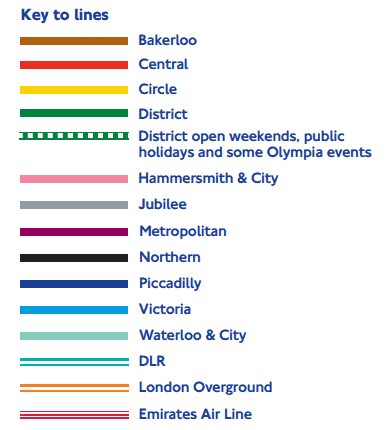
Generally speaking, any particular line will either head north-south or east-west.
FREE TOURS BY FOOT TIP:
Start your holiday in London with our All-in-One London Tour, which takes in most of London's legendary tourist sites and utilizes the London Underground. Get a tutorial directly from us.
OPERATING HOURS AND THE NIGHT TUBE
It’s important to remember that the London Underground system doesn’t run 24 hours a day every day and that timings may be different on weekdays vs. weekends.
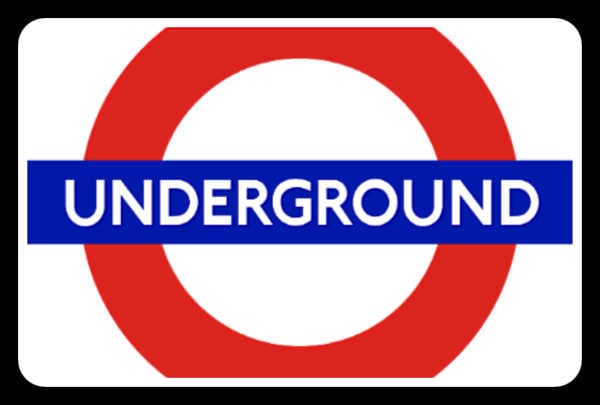
General Hours
Although each station has different timings, in general, the first tube trains start running around 5:00 am - 5:15 am and finish around 12:00 am - 12:30 am from Mondays through Fridays.
On Sundays, the Tube begins a bit later, around 6:00 am - 6:15 am and the final trains depart around 11:30 pm - 12:30 am.
Sundays also carry a reduced service which means there are not as many trains running as on Mondays to Saturdays.
Weekdays: 7:00 am - 9:30 am and 16:00 (4 pm) - 19:00 (7 pm).
Like any major city, London has a very busy rush hour in the mornings and in the evenings when the majority of people are travelling to and from work.
If possible, try to avoid travelling on the tube during these times, particularly if you have any large baggage/luggage with you.
Space is an absolute premium, which means you may have to wait as multiple trains pass you until there’s one with enough space to fit you in.
If you need a place to store luggage, read our advice here.
The Night Tube
As of 2019, some London Underground lines are now operating as The Night Tube, a 24-hour Underground service that operates on Fridays and Saturdays.
Really, this service should be called the "Overnight Tube" as the regular operating hours reach midnight every day of the week.
Click here for a downloadable pdf .

There are 5 lines making up the Night Tube and there are fewer trains operating, which means wait times are more than the standard 2 - 5 minutes.
The lines and approximate timings are:
- Victoria Line - Trains every 10 minutes
- Jubilee Line - Trains every 10 minutes
- Piccadilly Line (Cockfosters to Heathrow Terminal 5 ONLY) - Trains every 10 minutes
- Northern Line (Camden Town to Morden) - Trains every 8 minutes
- Northern Line (Camden Town to High Barnet) - Trains every 15 minutes (No Night Tube on the Bank and Mill Hill East Branches)
- Central Line (White City to Leytonstone) - Trains every 10 minutes
- Central Line (Leytonstone to Loughton/Hainault) - Trains every 20 minutes
- Central Line (Ealing Broadway to White City) - Trains every 20 minutes (No Night Tube on other branches of the line)
NOTE: The Night Tube operates with standard off-peak fare prices. Your daily travel card will be valid until 4:29 am the morning after you have purchased it.
TIPS ON NAVIGATING THE UNDERGROUND
Now we will provide you with our top 7 tips for navigating your way through the system, from how to enter a system, how to board the correct train, how to change lines, and when to walk instead of taking the Tube.
Underground Tutorial Tours
Let us, Free Tours by Foot , show you how to utilize the London Underground to get around the city - like our London in a Day or our Harry Potter Tour .

While these are not specifically Underground tours, your tour guide will assist you in learning how to master the system and to offer you some tips and tricks for riding the Tube.
1. Entering and Exiting Stations
All Underground stations have ticket barriers – large grey machines where travellers either insert their paper travel cards or tap their Oyster cards on top of them.
At first glance, most barriers all seem the same but they are actually divided into three different purposes; Enter, Do Not Enter, Bags/Buggies.

Some of the barriers will have a green arrow displayed – this means this is a barrier that you can travel through.
Insert your paper ticket, or tap your Oystercard on the yellow pad right next to the sign displaying the green arrow.
The barriers in front of you (just left from the arrow) will open and allow you to walk through.
Other barriers will have a red X displayed – this means this barrier will not open for you and is either closed or being used for visitors traveling in the opposite direction.
Lastly, some barriers are quite large, with signs displaying buggies, luggage, and wheelchairs.
These barriers are much larger than the regular grey ones and are there for people travelling with added items/persons.
They will not close as quickly as the others, giving travellers time to get themselves and all possessions through to the other side.
Read our post on taking the Tube from Heathrow Airport to Central London .
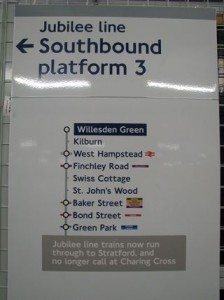
2. Find Your Correct Direction
In general, the Underground lines operate going north-south or east-west and vice versa.
Checking on your map will help you determine which direction you are travelling in, which will help you find the correct platform and train for your journey.
At every station, there will be maps like these showing the two directions that the trains will be travelling in, and under each direction will be a list of all the stations the train will stop at – in order!
This makes it easy not only to see which platform you need to be on but also how many stops it will take you to get to your destination.
3. Don't Board the Wrong Train
Sometimes, multiple Underground lines share the same track at a station. If you aren't paying attention, you could board the wrong train.
As the trains pull into the platform, you can take a glance at the front of the train. Here will be displayed the final destination of that particular train.
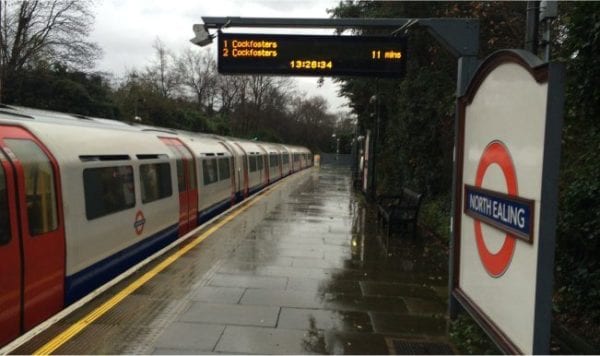
Also, on every platform there will be an electronic sign displaying the time until the next train arrives, and which station will be its’ final stop.

4. Lines that Split
Another potential mixup is lines that split. Some lines can have 2 or 3 different ending tracks, so you need to be aware of this.
Take the image below as an example.
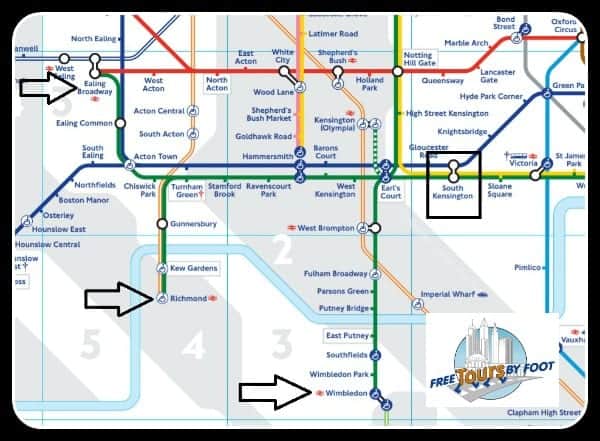
For example, suppose you plan on boarding a District Line (green) train at South Kensington Station (the black square) with a final destination Wimbledon (the bottom-most black arrow).
You would be taking a westbound train.
However, you can see from the map that there are two additional tracks with different ending points (Richmond and Ealing Broadway), all a part of the District Line heading westbound.
As you probably can tell, you could end up missing the first tennis match.
5. Changing Lines
The Tube map can often be misleading in that many tube lines crisscross over each other on the map, but do not actually connect to one another in reality.
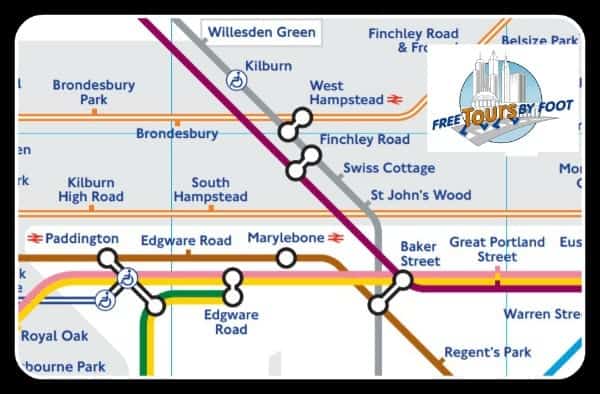
If you want to know where you can change from one Tube line to the other, you need to look for the white circle on the line on your map.
Any time you see one of these, it means you can change from one line to another or to British Rail.
Check out our tips on using the Underground with luggage and kids .
6. Sometimes You Should Just Walk
The London Underground Map is definitely NOT geographically accurate. Oftentimes it is easier to walk instead of getting on the tube to travel just a stop or two.
There is a map that gives the walking times between stations ( pdf ).
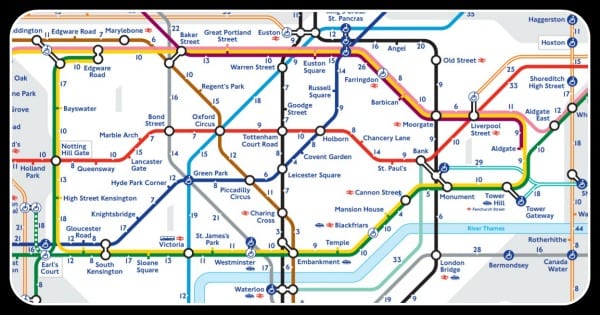
A good example of this is Leicester Square and Covent Garden on the Piccadilly Line.
On the map, they appear a fair distance apart, but in reality, it would take you just 4 minutes to walk the journey yourself.
Another good example is Charing Cross and Embankment - it’s just a 2-minute walk from each station!
7. Step-Free (Handicap) Access
For those with limited mobility, there are clues on the Underground map that will let you know if there is step-free access.
This is also useful if you are travelling with exceptionally heavy suitcases.
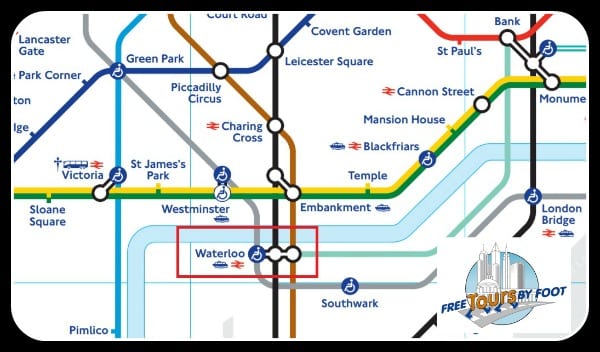
Simply look at the map, and on some stations, you will see a blue circle with a white figure in a wheelchair.
This means it is possible to get from the street into the train without any stairs or escalators.

The white circle and a blue figure in a wheelchair denote stations with step-free access from the street to the platform.
At these stations, you will need assistance to get into and out of the train, either with a ramp or the help of fellow passengers.
Note that in larger stations, such as Waterloo, the blue circle appears on one line only, which means the other two lines do not have step-free access. Transport for London has this helpful video .
A final note – Although London is generally a safe and welcoming city for visitors, pickpockets, and thieves operate throughout the entire London Underground network.
Please be aware of your surroundings, keep hold of all of your possessions, and avoid the habit of simply putting your ticket/credit cards/keys/mobile phones into your pockets – this will make you an incredibly easy target!
Also, never leave your belongings unattended on a train or in an Underground Station.
PICADILLY LINE TO AND FROM HEATHROW
By far the easiest and most affordable way to get to and from Heathrow Airport.
The Piccadilly Line runs through all 5 terminals of Heathrow Airport as well as straight through the centre of London, offering connections with every other tube line on the London Underground network.
Use our Google Map and input the address of your final destination for directions and travel time from Heathrow .
Travel time on the Tube is roughly 45 minutes to central London.
Piccadilly line trains run out of Heathrow from 5:00 to 23:00.
Ticket prices from Zone 1 to Heathrow are £6.70 for a cash-bought paper ticket, £5.60 on an Oyster card or contactless card at any time.
Read our full post on taking the Picadilly Line to and from Heathrow Airport .
TUBE ETIQUETTE
To avoid faux pas and keep from being marked out as a typical tourist, here are a few tips for Tube etiquette when travelling along the Tube.

1. Have Your Ticket Ready
Do not approach the ticket barriers until you have your Oystercard – or paper ticket – ready.
If you walk to the barrier and then fumble through your pockets/bags for your ticket, it will delay other travellers and oftentimes can mess with the barrier censors, potentially causing the barriers to lock.
[Remember you need a ticket both to BEGIN/ENTER and also to FINISH/LEAVE your journey!] Be sure to read our blog post on the Oystercard and Travel Card .
2. Stand on the Right
When riding escalators up and down in Underground Stations, please remember to stand on the RIGHT.
Travellers who wish to move up/down whilst on the escalators will be doing so on the left-hand side.
If you stand on the left you may find yourself politely asked to move to the right, or simply shoved past by a multitude of commuters.
This also includes your belongings/suitcases – they must be on the right of the escalators as well.
It is poor form and bad manners to take up the left side of the escalator with your belongings.
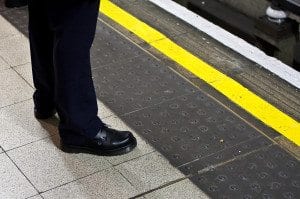
3. Stand Behind the Yellow Line
On every Tube platform, you will find a yellow line painted along the edge.
This line marks the boundary between where it is safe to stand, and where it is dangerous.
Stand BEHIND the line (not on top of!) in order to limit any risk of death or injury.
You may occasionally see passengers swiftly walking down the platform directly on top of the yellow line – but do not follow their lead!
4. Move Down the Platform
As soon as you get onto the platform, move either right or left.
You will find many people gathered at the entrance to the platform, meaning people cannot get past them and move onto the platform to get their train.
TIP : Besides just being courteous, the rear and front of the trains tend to be less crowded so moving down the platform means you’re more likely to get a seat!
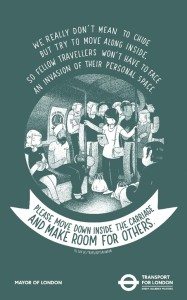
5. Let Other Passengers Off First
As soon as the Tube doors open, step to either side of the opening doors and let customers off the train before you attempt to board.
Failure to follow this rule may lead to verbal chastisement.
6. Move Down Inside the Carriage
Once you are inside the Tube – move away from the door! Standing in place will impede others who are trying to board.
Also (especially during peak times) it is important to move as far down into the carriage as possible in order for the maximum amount of people to fit onto the train.
You will see Londoners standing in between the benches on busy Tube carriages, and you should follow their lead.
7. Keep Feet and Bags Off the Seats
Particularly on crowded trains, it is unacceptable to take up an entire seat solely for your possessions – or your feet!
8. Do Not Lean on the Poles
The poles that are placed throughout the Underground train carriages are meant for people to hold on to.
Leaning against one of the poles means blocking the pole for those that may need it to hold balance whilst the train is moving.
9. Mind Your Earphones and Your Meals
The music you are listening to should not be loud enough for anybody else on the Tube to hear.
Also, it is best to avoid eating hot/smelly food on the Underground.
10. Get Out of the Way of Those Getting Off the Train
When you are on the Tube and at a stop that is not yours, make sure you are not in the way of those who are trying to exit the train.
Occasionally, you may need to step outside of the train to let passengers off if the carriage is very crowded.
This is expected behaviour, and you will be able to step right back on once the departing have left.
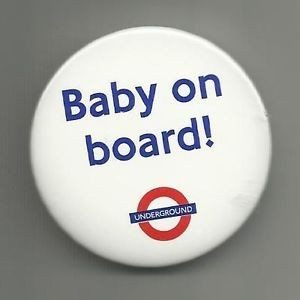
11. Stand Up for the Elderly and Pregnant
This is one even some Underground regulars need reminding of!
It’s just good manners in the UK to offer up your seat to the elderly, pregnant, or those who are less able to stand.
Be aware of who comes on the Tube at each stop and do not be afraid to offer your seat.
Occasionally you may see women with a small ‘Baby on Board’ badge with the London Underground logo pinned onto their coats.
Some men even take it upon themselves to stand up for any woman who comes onto the train so chivalry is not completely dead in London!
12. Take Your Rubbish Home With You
Rubbish left behind on the Tube is unsightly and can be quite disgusting.
There are no bins on Underground trains or at most Underground Stations which means it is expected that you will take any rubbish of yours off the train and home/back to your hotel with you when you leave.
On the London Underground, a little bit of courtesy and kindness can go a long way.
Commuting and travelling in the city can be quite stressful so try to remain courteous to others as you go about their business, and hopefully, they will do the same as you go about yours
HOP-ON-HOP-OFF BUS VS. LONDON UNDERGROUND
If you’re visiting London and aren’t sure about riding the London Underground, then we hope our tips above have made you more confident and willing to use the tube to get around town.
However, we understand that some people may still be a little anxious or unsure about the benefits of taking the tube, as opposed to riding one of London’s hop-on-hop-off tour buses.
To help you make up your mind, we’ve listed a few pros and cons of each below.

Hop-on-hop-off buses can be useful in getting an overview of the city or learning your way around town.
They are also quite useful for people who aren’t physically fit enough to walk through London day in and day out.
However, whenever possible, we strongly believe that the best - and the quickest - way to get around town is by taking the London Underground or to walk.
[Note that if you wish to take a hop-on-hop-off bus tour, we have a handy page HERE to help you choose which one to ride]
Pros of a Bus Tour
- easy to understand routes
- convenient stops at the most popular tourist attractions
- climate controlled all year (on the inside)
- tickets often include night tours, boat cruises, or free attractions.
- commentary along the routes
Cons of a Bus Tour
- more expensive than riding the subway
- routes are only one-direction
- wait times can be very long due to seasonal or even daily traffic
- buses can be crowded
- bad weather is always a risk
Pros of Riding the Underground
- (relatively) inexpensive
- flexible routing
- very warm in the winter
- you get to travel like a real Londoner
- Almost always faster than a bus
Cons of Riding the Underground
- not all stations are accessible for wheelchairs and strollers
- can be really hot and sweaty in summer
- can be really crowded during rush hours
- no commentary
Related Content
- Which Oystercard to Buy
- How to Get from Heathrow to London Centre by Underground
- How to Get from London to Paris by Train
- Things to do in London
- Most Haunted Places in London
Choose a Destination... I want them all PLUS general travel tips. Amsterdam Berlin Boston Charleston Chicago Dubai Lisbon London Los Angeles Miami Nashville New York City New Orleans Paris Philadelphia Prague Rome San Francisco Washington DC
About The Author

North America
United kingdom & ireland, middle east & india, asia & oceania.
Account Options

Type and hit Enter to search
Detailed guide to london zones 1 to 6.
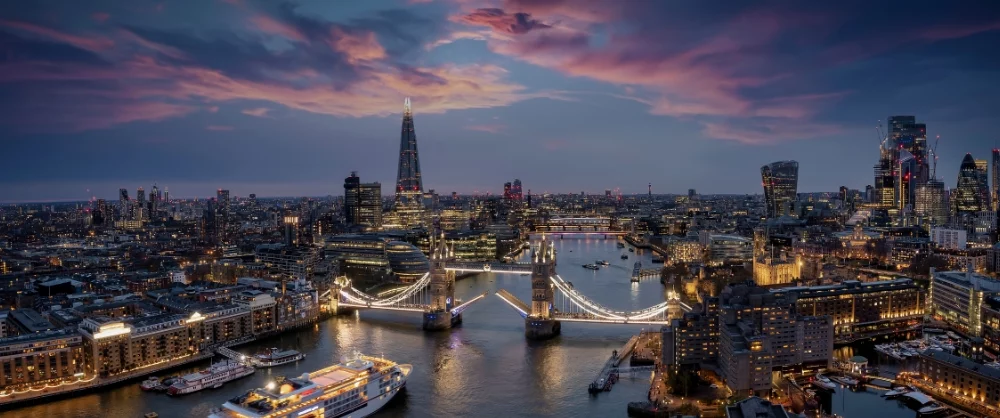
Table of Contents
London is the capital city of England and the United Kingdom , stretching an area of 1,572 km2. There are 32 boroughs in London, which requires an efficient transportation system. Thus, London is divided into different zones, namely 1-9 zones, but most fit into 1-6 London zones.
Zone 1 is central London, and Zone 9 is the outskirts of London.
The London zone system was developed to connect these zones. Each zone is given a station on the London Underground, London Overground, Docklands, Light Railway, and National Railway.
London is expensive, and cracking the way on how to travel through these zones can save you big bucks! So, here’s a guide to familiarize you with each zone in London. Find out the zone that is close to your student accommodation in London .
What are the different zones in London?
There are 6 main London zones which are listed below:
- Zone 1- Central London
- Zone 2- Inner London
- Zone 3- Between Inner London and Outer London
- Zone 4- Outer Part of London
- Zone 5- Suburbs of London
- Zone 6- Suburbs of London
What is London Zone 1?
London Zone 1 covers central London and fare zones of 2, 3,4, 5 and 6 forming a concentric circle around it. It is the main transportation station for London’s zonal fare system.
Areas covered in Inner London: Central London: City of London, Camden, Hackney, Islington, Kensington & Chelsea, Lambeth, Southwark, Tower Hamlets, Wandsworth and Westminster
The major attractions in London Zone 1 are Big Ben, the Houses of Parliament, the Tower of London, the London Eye, Madame Tussauds, the British Museum, the Science Museum, etc.…
What is London Zone 2?
London Zone 2 is the inner city that rings around Zone 1. It is not in the city center but closer to the center than zone 3. The zone covers areas and neighborhoods close to central London.
Areas covered in Inner London: Camden, Hackney, Hammersmith & Fulham, Islington, Kensington & Chelsea, Lambeth, Lewisham, Newham, Southwark, Tower Hamlets, Wandsworth and Westminster.
Areas covered in Outer London : Brent, Ealing, Greenwich, Hounslow, etc.
The main attractions in London Zone 2 are Regents Park, London Zoo, Shoreditch, Arsenal FC Stadium, Chelsea FC Stadium, Clapham Common, etc.
What is London Zone 3?
London Zone 3 is the inner zone of Transport for London’s zonal fare system. London Zone 3 rings around zone 2. It is 29 minutes away from Central London.
Areas covered in Inner London: Camden, Hackney, Haringey, Islington, Lambeth, Lewisham, Newham, Southwark, Wandsworth, etc.
Areas covered in Outer London: Barnet, Brent, Bromley, Croydon, Ealing, Greenwich, Hounslow, Merton, Richmond upon Thames, Waltham Forest, etc.
The main attractions in London Zone 3 are Wimbledon, Kew Gardens and London City Airport, Elephant and Castle ( 11 min underground), London Bridge (12 mins), etc.
What is London Zone 4?
London Zone 4 is the outer zone of Transport for London’s zonal fare system. Zone 4 rings around zone 3. London Zone 4 is only 33 minutes from Central London (Zone 1).
This zone is emerging as a livable area in London. Areas covered in Inner London: Barking and Dagenham, Barnet, Bexley, Brent, Bromley, Croydon, Ealing, Enfield, Greenwich, Hounslow, Kingston upon Thames, Merton, Redbridge, Richmond upon Thames, Sutton, Waltham Forest, etc.
Areas covered in Outer London: Epping Forest (Essex)
The main attractions in Zone 4 are Petersham Nurseries, Eltham Palace, Modern Hall Park, Bang Bang Oriental, Kingston Upon Thames, RAF Museum, etc.
What is London Zone 5?
London zone 5 is an outer zone and rings around zone 4. Zone 5 is 30 minutes away from Central London (zone1)
Zone 5 covers Outer London and Outside London areas:
Areas covered in Outer London: Barking and Dagenham, Barnet, Bexley, Bromley, Croydon, Ealing, Enfield, Harrow, Hillingdon, Hounslow, Kingston upon Thames, Richmond upon Thames, Sutton, Waltham Forest, etc.
Areas covered in Outside London: Epping Forest (Essex), Epsom and Ewell (Surrey)
The main attractions in London Zone 5 are Eel Pie island, Ruislip Lido, Alexandra Palace, Kew gardens, etc.
What is London Zone 6?
London Zone 6 is the outer zone of Transport for London’s zonal fare system. Zone 6 rings around zone 5. Zone 6 covers outer London and outside London areas:
Areas covered in Outer London: Bexley, Bromley, Croydon, Enfield, Harrow, Havering, Hillingdon, Hounslow, Kingston upon Thames, Richmond upon Thames, etc.
Areas covered in Outside London: Elmbridge (Surrey), Epping Forest (Essex), Epsom and Ewell (Surrey), Hertsmere (Hertfordshire), Reigate and Banstead (Surrey), Tandridge (Surrey), Three Rivers (Hertfordshire, etc.
What are the types of Transportation in London Zones?
Staying in London is a blessing in disguise. It’s expensive, yet with its cost-efficient transportation system, it’s cheap, comfortable and easy to travel around the London zones. Below are the types of transport in London zones:
London Underground
The London Underground is one of the world’s oldest underground railways. It is the rapid transit system serving all 9 London zones. Also known among the locals as the ‘ Tube.’ It is identified by its blue and red roundel across the city. It is part of the TfL transport system with over 270 stations across London.
The 24-hour service is on Jubilee, Victoria, Central, Northern and Piccadilly Lines.
Payment: You can pay using an Oyster card or contactless.
London Overground
London’s overground suburban rail network serves the London zones. It is part of the National Rail, but a branding of TfL, which is assigned as an Orange roundel in all stations, maps, trains, etc.
It operates above street level from the city center to another metropolitan area outside of central London. It covers about 71% of London districts, covering 100 stations. London Overground has limited 24-hour services.
Docklands Light Railway
Docklands Light Railway is an automated light metro running on 149 trains except for the four below-ground stations. It is part of the London Ground Network. It covers dockland areas of London, east and south-east London, and connects with cable car and Emirates Airline.
On weekdays, it starts from 5:30-12:30 am, while on weekends, it starts late and finishes early.
London Buses
The London Buses has been part of the public transportation since 1829. It is cheap, efficient, and part of the zone system. The buses travel to many routes and bus stops, with the hopper fare allowing you to take many rides at a low price.
If you have a travel card, you can use it in all of London, even from zone 1 to zone 6.
Emirates Air Line (Cable Car)
The London cable car is known as Dangleway, but today, it is called the Emirates cable car as its sponsored Emirates. The cable car links across the River Thames, London, England. It is about 90 m ft, offering panoramic views of London city. The cable car is part of the Tlf transport system traveling from Greenwich to Royal Victoria Dock.
The cable car travels to all London zones.
The River Bus
The river bus has six routes from 23 piers between Putney and Woolwich. It is operated by Upper Boat by Thames Clippers. The river bus is a covered boat with an open outside deck area. There’s a place to eat and enjoy snacks, too. You can get access to toilets too. Bikes are allowed, and dogs need to be on a lead.
The boat departs every 20 minutes; therefore, plan your journey for the zones in London. The River Bus is among the best ways to enjoy London’s riverfront and scenic beauty.
How to pay for the London travel zones
The most common modes of payment for traveling on London transport systems are listed below:
Travelcards
Travel cards are available on a weekly and monthly pass, giving you unlimited travel on trams and buses.
It is valid in all London zones. It is a bit more expensive than an Oyster card. They can be loaded into your Oyster cards.
To travel from Zone 1 to Zone 3, you will need a Zone 1-3 travel card.
A Day Travel Card Cost
- Zones 1-2: Cost £15.20
- Zones 1-3: Cost £15.20
- Zone 1-4: Cost £15.20
- Zone 1-5: Cost £21.50
- Zone 1-6: Cost £21.50
Oyster Cards
The visitor oyster card is the only card offering discounts on all London fare zones. It’s non-refundable. The regular oyster card is a card that doesn’t expire. It is refundable with a £5 security deposit. The top-up costs £5, and the card price is £7. It is available at all tubes, most overground and Elizabeth line stations, and DLR stations.
Oyster cards are not accepted between Reading and Iver.
A Day Oyster Card Cost
Zones 1-2: Cost £8.10
Zones 1-3: Cost £9.60
Zone 1-4: Cost £11.70
Zone 1-5: Cost £13.90
Zone 1-6: Cost £14.90
Contactless Payment
A foreign card is accepted as a form of contactless payment option. It can be a credit/debit card, and you can make countless purchases. The card can be used to pay for all modes of public transportation. If you have used an Oyster card, it works similarly. You can swipe at the ticket barriers at the start and end of your journey. Make sure you keep track of the cost of the ride.
Add supported payment to Apple Pay and swipe through iPhone or watch.
We'd love to hear from you !
Share article, other articles.

Regal London to Transform Orchard Wharf into Mixed-Use Development
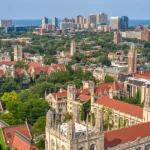
Best and Oldest Universities in the US
Related posts.

10 Best Nigerian Restaurants in London

Top 10 Research Topics For Students
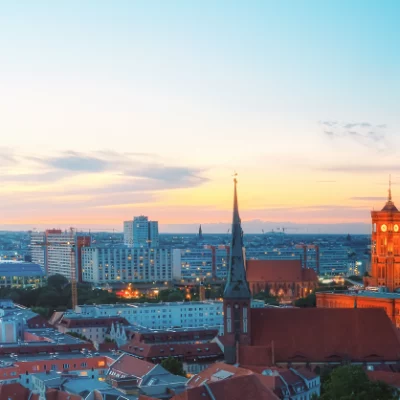
Explore the Best of Berlin

Top 10 Student Skills For Success & Growth
A Visitor’s Guide To London Public Transport

London is a massive city, covering some 607 square miles (or 1,572 km). Despite its size, the city maintains an effective and efficient public transport system that connects all 32 London boroughs.
With the ‘tube’, overground, river buses, a tram system – even a cable car – available to get around, there are plenty of transport options available.
That’s not to mention the various ways you can pay to travel, including contactless payment cards, Oyster cards and paper tickets.
It’s unsurprising, then, that first-time visitors to the city are often overwhelmed. Read on to find out more about each transport option and our recommended best way to pay for travel.
The ‘Zone’ System Explained
When it comes to getting around, London is divided into ‘zones’ 1-9, with ‘Zone 1’ being the city centre and ‘Zone 9’ being the outskirts of the city. The system itself exists as a method for TfL (Transport for London) to calculate a customer’s travel distance and charge accordingly.
Realistically, most visitors to the city will never have to travel outside of ‘Zone 1’ as this is where most of the main attractions and the city centre are located. However, for those venturing further afield, it is important to consider how many ‘Zones’ you’re travelling through as this will affect the type of ticket you need to buy.
The time of day that you travel will also affect travel costs; TfL charges higher fares at busier times of the day, also known as ‘peak hours’. These hours (excluding public holidays) are from 06:30-09:30 and 16:00-19:00 , Monday-Friday.
The ‘Zone’ system does not apply to buses in London – you can travel anywhere in zones 1-9 on any travelcard.
The London Underground, aka the ‘Tube’

The London underground (known by locals as the ‘ Tube’ due to the fact some tunnels on the network are, quite literally, round tubes running through the ground) is the world’s oldest underground rail system . A red and blue roundel identifies underground stations across the city.
- Pay using contactless or Oyster card
- Part of the TfL transport system
- Hundreds of stations (270)
- 24-hour service on the Victoria, Central, Jubilee, Northern and Piccadilly lines
- Cash not accepted
The Overground

Not to be confused with the ‘Tube’, the overground, as the name implies, operates above street level and connects the city centre with the wider metropolitan area. It was launched in 2007 to provide better connections between areas outside of Central London.
- Services 71% of London Boroughs with over 100 stations
- (Limited) late night service that runs into the early hours
DLR (Docklands Light Railway)

Unlike the rest of London’s transport network, the DLR is a fully automated system with no drivers. Covering the docklands area of London, the area directly east and south-east of Central London, the DLR also connects with London’s cable car, the Emirates Air Line.
- Completely driverless!
- Relatively small/limited network
London Buses
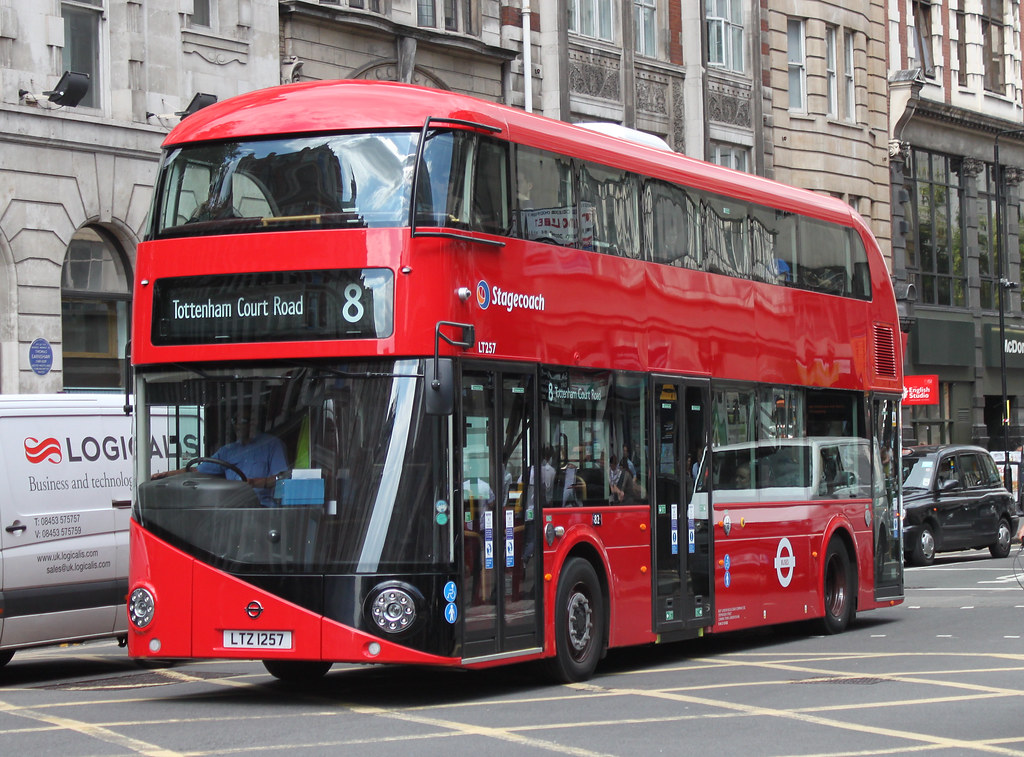
Buses in London are not only a fantastic way to see the city, but they also have one major advantage over every other transport method: they aren’t restricted by the ‘zone’ system.
What does this mean? Each journey you take, no matter how far you’re travelling or where you’re going, will cost you a flat fee of £1.65 for a single journey. They also have the advantage of the hopper fare ; take as many bus journeys as you want inside 1 hour and never pay more than the flat £1.65 fee.
- Cheap, efficient way to travel
- Thousand’s of routes and bus stops
Emirates Air Line (Cable Car)

Don’t be fooled by its misleading name; the highest you’ll get above London on the UK’s only urban cable car system is 90m (295 feet).
More spectacular than practical, enjoy beautiful panoramic views across London as it travels from Greenwich to Royal Victoria Dock. As part of the TfL system, you’re able to pay using your Oyster travel card contactless card – exactly the same as if you were travelling by bus or train.
- Panoramic views across London
- Limited route
- Slow travel time
Bicycle (aka “Boris Bikes”)

London’s public cycle hire scheme, Santander Cycles (known locally as ‘Boris Bikes’), features more than 12,000 cycles at 800 docking stations. The number of cyclists on London’s roads has more than doubled in the last decade, in large part due to the introduction of cycle hire, and cycling around the city is a great (and eco-friendly) way to explore.
- Great way to explore and get exercise
- Easy – pay using the official app or by card
- Cheap – £2 to access a bike for 24 hours (the first 30 minutes of each journey is free)
- Can only pay via bank card at the docking station

The confusingly named ‘River Bus’ operates 6 routes running from 22 piers along the River Thames between Putney in the West and Woolwich in the East.
With departures only every 20 minutes or so, we would recommend planning your journey in advance to avoid delay. If you’re not in a rush, the river bus is a great way to travel around the city and enjoy great views of London’s riverfront.
- Great views
- Infrequent departures
- Slow travel times
Paying For Travel
In our guide below, we’ve outlined the pros and cons of each travel payment option and provided our recommendation on which one to purchase ahead of your trip to London. Use this guide to work out which London travel card is right for you.

Outdoor activities you can enjoy with your family in the UK in 2024

The Ultimate 2023 Guide to Nightlife in London
Related posts.

6 reasons to experience ABBA Voyage in London

Britain’s 5 best-loved UNESCO world heritage sites

Gems Of Knowledge: Why it pays to take a guided tour
- London Tourism
- London Hotels
- London Bed and Breakfast
- London Vacation Rentals
- Flights to London
- London Restaurants
- Things to Do in London
- London Travel Forum
- London Photos
- All London Hotels
- London Hotel Deals
- Last Minute Hotels in London
- Things to Do
- Restaurants
- Vacation Rentals
- Travel Stories
- Rental Cars
- Add a Place
- Travel Forum
- Travelers' Choice
- Help Center
Travel zone 1 - 6 - London Forum
- Europe
- United Kingdom (UK)
- England
- London
Travel zone 1 - 6
- United States Forums
- Europe Forums
- Canada Forums
- Asia Forums
- Central America Forums
- Africa Forums
- Caribbean Forums
- Mexico Forums
- South Pacific Forums
- South America Forums
- Middle East Forums
- Honeymoons and Romance
- Business Travel
- Train Travel
- Traveling With Disabilities
- Tripadvisor Support
- Solo Travel
- Bargain Travel
- Timeshares / Vacation Rentals
- England forums
- London forum

The Travelcard is capped at £15.20 off - peak and you get 30% off the boats, the Oystercard capped at £14.90 any - time and you get 10% off the boats.
Everywhere I read says get the Oystercard, but you pay £7 for the card, am I missing something here.
6 replies to this topic

"Everywhere I read says get the Oystercard, but you pay £7 for the card, am I missing something here."
Here we say don't get an Oystercard unless you are aged between 11 and 15 as that allows you to add the young person discount
The daily cap for zones 1-6 is now £15.60 all day since last month.
Using contactless on the transport is the same fares and cap as using oyster cards without the initial £7.00 fee.
" Everywhere I read says get the Oystercard "
You might be reading out of date information.
Oystercard 'was' the leading edge best value solution a few years ago, but to a great extent it has now been supersed by Contactless Credit Card for Tap&Go (or Debit Card or Phonepay or Watchpay).
Some people still prefer to use Oyster, but that has been overtaken by the other options that have no setup cost or requirement. They provide the same discounted travel, with free rides each day once your capping limit has been reached.
Just tap in and out at the gates on the underground. Your fare is calculated and you won't pay more than the daily cap.

The two main reasons why you need an Oyster card are to:
- add a discount
- add a season Travelcard
These can't be done with a contactless bank card.
- On London now-Question 6:26 am
- Sunday Roast in a pub on final day of Euro 2024? 6:15 am
- Kids at the National Gallery 6:14 am
- Euston Station drop off (private car) 6:12 am
- Wembley Stadium post match travel 6:05 am
- Recommendation for best area to stay for short overnight tri 5:13 am
- Public Transport Transfer Tix 5:01 am
- Contactless Payment for Train at Gatwick Airport? 4:46 am
- Second M25 weekend closure 4:31 am
- TALF pub meet - Thursday April 18th at The Lamb in... 4:04 am
- Lot happening this weekend 20/21 April 4:01 am
- National Express 3:54 am
- Outlets by public transport 3:25 am
- Recommendations please 3:18 am
- Best Area of London to Stay for 2 nights 15 replies
- How to get to Victoria Station from Heathrow? 10 replies
- The London Pass...worth it or scam? 10 replies
- Best hotel for Heathrow Terminal 3? 8 replies
- Hostel/Hotel Near Liverpool Street Station 4 replies
- outlet shops in London? 12 replies
- Heathrow to Kings Cross 7 replies
- London - factory / designer outlet malls 12 replies
- weather in december 5 replies
- Best Area to Stay in London 8 replies
London Hotels and Places to Stay
- What can I do in London on a budget?
- How to use Oyster Cards, Travelcards and 2-4-1 offers in London?
- What is open in London on Christmas Day
- The Championships, Wimbledon
- Harry Potter in London - FAQ


How to Get Around London: A Guide to the London Public Transport System
T his comprehensive guide to getting around london will help you understand and navigate the london public transport system so that you can spend more time enjoying the city instead of deciphering underground maps.
First of all, if you’ve decided on visiting London, let me congratulate you on your excellent taste. It’s my favorite major city in the world and one of my all-time favorite destinations. While there are a million things to do in this amazing city, I want to be sure you know how to get around London before you go.
Our family spent several months living in London without a car and also several months living outside the city, and we have also been back to visit several times. Using London public transport is one of our favorite things to do in London and I think it’s actually part of the fun of this city and what makes it so special. While the London transport system is as extensive as the human nervous system, it can also be simplified and easy to use.
Since it’s such a huge city, getting around London can consume a good portion of your trip, but I’m going to share some tips that will help you to understand your options and make the most of your time. Sometimes transportation in big cities can be kind of a drag, but in this city, it’s all so iconic, clean and easy that it makes getting around London part of your true experience. Here are some tips to help make getting around London life go smoothly.
Don’t have time to read a bunch of reviews and blog posts? Here are our top picks for visiting London:
Wanderlust london guide.
If you’re traveling to London, you’ll want to have a solid itinerary that will help you organize your time in the best way possible and maximize your time and money. I’ve created this 5-day London itinerary that will help you see the best sites in London along with some hidden gems. It contains open-and-go day-by-day schedules and expert advice from me!
Our favorite Hotels in London
- Marriott County Hall
- Georgian House Hotel (Harry Potter Chambers)
- The Mad Hatter Hotel
- H10 Waterloo
Must Have: London Pass
Our Favorite London Activities
- Hop On Hop Off Bus
- Tower of London
- Harry Potter Studio Tour
How to Get Around London: The London Public Transport Zones
London is conveniently…or maybe just confusingly…divided into 9 different zones that determine your fare on most public transport. The zones are circular with 1 in the center and 9 being the outer circle. Zones 1 and 2 are contained in central London. In the London transportation system, the fare generally gets more expensive the more zones you cross.
How Much Does it Cost to Use London Public Transport?
Getting around London is fairly affordable, especially if you’re traveling with kids , since ages 10 and under ride anything that uses an Oyster Card for free, including the Underground and the Bus. Fares for riding each mode of transportation differ. The London buses cost around £1.5 per ride. A single tube fixed price is £2.40 with an Oyster card, but the card has a daily cap and even weekly cap which you can see in the chart below, which means that if you’re riding London public transport all day long you are saving a ton of money.
Different Types of London Public Transport
- Underground
- National Rail
- Heathrow Express
I know that list seems long and scary, but don’t be worried, it’s great to have options and you don’t need to use all of these! I’m going to break down each option so you’ll know the ones that will work best for you.
1. The London Underground
The most well known, and most used London public transport is the London Underground, also known as “the Tube.” It is the oldest underground transportation network in the world, first opening in 1863, and carries over one billion passengers a year. The system is vast, with over 250 miles of track and over 200 stations.
The London Underground is the best way to get around London if you want to move quickly across a large area. And thanks to its efficiency, trains are usually on time. You can easily find “Tube Stations” all around the city that will allow easy access to its 11 different colored lines. The stations are easily recognizable with the big red circle with “UNDERGROUND” written across it.
Trains generally run at least every 10 minutes between 5 am and midnight, some lines offering 24-hour lines. You can plan your journey on the London Underground here or you can use Google Maps on your phone. To ride the London Underground, you’ll need a ticket or an Oyster Card. Oyster cards are plastic credit card like passes that you can “top up” (add money to) at any time.
They work on the underground, bus systems, and some National Rail. Children 10 and under ride the bus and tube for FREE ! To buy your Oyster card, find a machine in any Tube station or ask an attendant. To ride the Tube, hold your Oyster Card over the indicated area on the barriers on your way in and out. The barriers will automatically deduct your fare from your card.
2. Black Cabs
Of course, you can’t leave London without getting a ride from a London Cabby. The cabbies are required to take a difficult test to get this job. It can take years to study and pass the test and they must know the streets of London like the back of their hand! If you want to know about something you pass, ask the cabby, he most likely knows a bit about everything! London cabs seat 5 in the back.
They can get quite expensive so we try to save them for a rainy day (literally). Some cabs take credit cards, but about 80% of the ones we took were cash only. Fares are metered and paid upon completion of the journey. As a common courtesy, it’s always a good idea to go to the passenger window of the cab before getting in and telling them where you’re going to be sure they are willing to go there, especially if it’s far.
When the Taxi sign is lit, the cab is empty. To hail a cab, stand on the curb and hold your hand up. Also, look for designated Taxi pick up spots and be sure not to stand on a “zebra crossing” because they are not allowed to stop there.
My personal favorite way of getting around London is in the iconic red double-decker buses. With over 2 billion journeys a year taken by bus in London, this is the most popular mode of transportation in the city, and for good reason. Here are a few reasons why I think the bus is the best way to get around London:
- Cheap: There is a set fare per journey, so even if you’re going from one end of the city to the other, your fare is still only 1.50 pounds! Also, kids 10 and under ride free!
- Convenient: There are literally bus stops on almost every corner of London and the buses run continuously throughout the day and night, even stopping where there may not be an Underground station.
- Accessibility: If you’re getting around London in a wheelchair or with kids in strollers, the bus is the most easily accessible mode of transportation, lacking the necessity of stairs. If you have a stroller you can just wheel it right on to the bus.
- Oyster Card: You can pay for the bus using your Oyster Card by simply touching it to the yellow reader. You only need to use it at the beginning of your journey.
- The View: Riding the bus in London provides you with incredible views of the city and allows you to see more of London while in transit than you otherwise would by being underground on the Tube. Yes, it’s slower than the Underground due to being restricted by traffic, but I think the trade-off is worth it.
4. River Bus
Guess what else you can use your Oyster Card on? That’s right, you guessed it: the riverboats of London known as the Thames Clippers River Bus. I feel like this is one of the most underutilized modes of transportation in London. Maybe because it’s a little pricer or because the boats don’t run as frequently as the buses or the Tube, but the riverboats can be a convenient way to get across the city while seeing it from a truly unique perspective.
5. Overground
The London Overground is pretty much the Underground, but, you guessed it, above ground (even though much of the Underground is also above ground). The overground is fairly new and basically covers areas that the Underground does not. You can use your Oyster Card on the Overground and the fare system with zones is the same as the Underground.
6. DLR (Docklands Light Rail)
This fully automated rail system (without any drivers) services mostly the East and South of Central London near the docklands area of London. It works just like the Underground and Overground and you can use your Oyster Card.
7. National Rail
What?! More trains? Yes! Most national rail services consist of several different lines that connect London to the rest of the country. Many commuters use these rail lines to commute from the suburbs surrounding London. Your Oyster Card will not work on National Rail lines and children 10 and under are not free, but usually ride at a discounted rate. There will be machines at the station where you can purchase rail tickets and usually a ticket office where you can talk to a human.
8. TramLink
This small tram system services South London, so if you’re staying there you’ll need to know about this one. The TramLink has a fixed fare and works like the bus so you only need your Oyster Card on the way in, not the way out.
9. Heathrow Express
If you’re coming to London you’re most likely flying into Heathrow Airport, London’s largest international airport. If so, taking the Heathrow Express is the fastest way to get into the city center. Don’t make the newbie mistake of taking a cab all the way into London! Book your tickets ahead of time online here to get the best deal. Fares range from £5-£32 depending on when you book.
10. Ride Share
- UBER : UBER is regularly used and accepted in London. It’s an easy way to book and pay for transportation and you can now split fares with your travel buddies. It’s not quite the same experience as riding in a Black Cab in my opinion, but just as efficient. When we were there we found the price to be about the same, but you don’t have to worry about having cash on you for UBER at least. If you’ve never used UBER, don’t worry it’s fun, safe, and easy. Here’s a coupon for $5 off your first ride.
- Free Now : Despite its name, Free Now is not free, but it will save you a few pence! What I like about Free Now is that you can call a regular car or a black cab, which is much easier than trying to hail one down on the street! I’ve also found it to be a bit cheaper than UBER. Download Free Now for Apple . Download Free Now for Google .
Biking around London can be a really fun and inexpensive way to see the city and get you from place to place on a nice day. The bikes with “Santander” written on them are affectionately known as “Boris Bikes” after Boris Johnson who was the Mayor of London when the bike program launched.
The bikes only cost £2 to access the bikes and the first 30 minutes are free. You could technically bike somewhere for 30 minutes, check in your bike, then check out a new bike and ride it for 30 minutes and so on, potentially paying only £2/day for your bike. There are 750 docking stations and 11,500 bikes to rent around London. You can use a credit card or the app to pay for your bike.
London has also recently put in millions of pounds to creating more bike lanes around the city to help the environment and the flow of traffic. They’ve done a nice job and you’ll see dedicated lanes for bikes all around the city, and especially in the most congested areas.
If you want to know how to get around London on a bike, you can learn more about the London Bike Scheme here .
12. Walking
Walking is a great way to see a lot of London. Most things in central London can be seen by walking and it’s a great way to make more room for all those delicious foods you’ll be eating! Plus, if you’re on a budget it’s the best way to get around London. Be sure to check the distance between you and your destination on Google Maps. You’ll be able to see a different view of London by walking the city. London is full of beautiful parks and they can make great short-cuts and lovely walks.
What is the Best Way to Get Around London?
While there’s no right or wrong answer to this questions, I definitely have my favorite ways of getting around London. As I’ve stated above, the bus is my personal favorite way to travel in London, but the Underground may be the fastest. If you’re lucky, you’ll have the chance to use every mode of transportation during your time there.
Do You Need an Oyster Card to Travel in London?
Having an Oyster Card in London is not strictly required, but I would highly recommend getting one. A London Oyster Card is the cheapest way to get around London, it covers journeys across London’s public transport networks including the Tube lines, buses, overground train station, and DLR, and can be used any time of the day throughout the week.
It makes life easier and will be more affordable. There is actually a price cap currently of £9.80 for zones 1-4. So you know that you won’t be paying more than that each day you are in London, regardless of how many times you ride. This article from London Toolkit about the London Public Transport fares was really helpful.
Go Contactless
Use your contactless card, phone, or watch to pay for the tube map. Now riding the tube and bus is even easier with contactless payment. Just use your card, phone, or watch as you would when making a purchase. Be sure to “swipe” in and out using the same contactless card so you’ll be charged the correct fare.
Tips for Getting Around London
- Buy an Oyster Card or Prepare Contactless Payment in Advance: Having an Oyster Card is a great option as it will allow you to ride multiple forms of transportation around London without having to purchase single-ride tickets.
- Download Google Maps App and use it! Even if you have to look up directions before you leave wifi. I recommend using google maps public transit directions. These have almost never failed me! The app gives you train or bus times and even track numbers, alternate train times, bus stop letters, and exit names. Google Maps will also provide you with several options for public transportation around London. You can see below that to get from the Tower of London to Westminster Abbey using public transportation you have the option to take the Underground or the River Boat.Along with detailed public transport maps and directions, Google Maps will also provide detailed walking directions from the transit stop to the destination.
- Mind the Gap: Those signs everywhere that say “Mind the Gap”…they’re no joke! During my last trip to London, my nephew got stuck in the gap. It was pretty scary, so just be careful.
- Stand on the Right: When riding on the escalators, stand on the right or walk on the left.
- Travel During Off Peak : Try to avoid using public transportation between 7-9 am and 5-7 pm when trains and buses are crowded.
- Try New Things: Don’t be afraid to try different types of transportation like riverboats.
More London Resources
If you need more help planning your trip to London, check out these great resources!
7 Day London Itinerary
London With Kids
Paddington’s Guide to London
Christmas in London
FAQ on How to Get Around London
There are several ways to get around London on a budget. The best way to save money is by taking public transportation such as the Tube, buses and overground trains. You can also rent a bike or walking is always free. Getting an Oyster card and using contactless payment are great ways to pay for your journeys. Additionally, look out for special offers and discounts when travelling.
The current price is £7 and £9.80 for zones 1-4. You can always top up your Oyster card with cash whenever you need.
It costs £20 for the Visitor Oyster card. This allows you to save £1.75 for a single journey with £5.25 as a daily cap. That’s why many tourists and even locals opt for the Visitor Oyster card when travelling around London.
Yes, as the underground stop is usually within walking distance from most places, it makes traveling around London easy. Trains always arrive in 10 minutes and the system is well connected. Additionally, there are Uber rides that are perfect for sharing in groups and other taxi services.
I hope this guide to getting around London has been helpful. You are going to love this city, and now that you know how to navigate it you’ll feel more comfortable and be able to enjoy seeing the sites without stressing about how to get between them. If you have any questions about how to get around London, please ask! You can message me on Facebook or Instagram . -Vanessa
The post How to Get Around London: A Guide to the London Public Transport System appeared first on Wanderlust Crew .
![This comprehensive guide to getting around London will help you understand and navigate the London Public Transport System so that you can spend more time enjoying the city instead of deciphering Underground maps! How to Get Around London: A Guide to the London Public Transport System First of all, if you’ve decided on visiting London, [...] This comprehensive guide to getting around London will help you understand and navigate the London Public Transport System so that you can spend more time enjoying the city instead of deciphering Underground maps! How to Get Around London: A Guide to the London Public Transport System First of all, if you’ve decided on visiting London, [...]](https://img-s-msn-com.akamaized.net/tenant/amp/entityid/AA1cfSdp.img?w=768&h=515&m=6)
1.5 billion more passengers flew last year than in 2022. These are the 10 busiest airports in the world.
- New data on the world's busiest airports in 2023 reveals the latest trends in global travel.
- 8.5 billion passengers traveled by plane last year, almost marking a return to pre-pandemic levels.
- Airports in Asia and the Middle East became busier, but the US has once again clinched the top spot.

International travel is almost back to pre-pandemic levels, according to the just-released list of the world's busiest airports in 2023.
8.5 billion passengers traveled globally by plane last year — up from 7 billion passengers in 2022 .
The rise in air travel marks a recovery to 93.8% of levels in 2019 before the world shut down, according to preliminary data published by the Airports Council International (ACI), a trade association that includes 2,600 airports worldwide.
Increasing travel to airports in Asia and the Middle East was one of the key trends to emerge from the data, with Dubai International Airport jumping from the fifth to the second busiest airport in the world.
Airports in India, Japan, and Turkey also made it into the top 10 and were some of the biggest movers in terms of annual gains in passenger numbers.
As the world's largest domestic market for flights , US airports still make up five of the busiest airports in the world, with Hartsfield-Jackson Atlanta International Airport retaining its No. 1 position.
Despite tough global economic conditions, there was "a growing inclination towards travel," Luis Felipe de Oliveira, the ACI's world director general, said in a press release.
"Airports continue to demonstrate their resilience and adaptability amidst the challenges posed by the ever-evolving landscape of global travel," said Oliveira.
Here's a closer look at the top 10 busiest airports in the world.
10. Indira Gandhi International Airport, Delhi, India
Passengers: 72.2 million
2022 ranking: 9th
Delhi's main airport, Indira Gandhi International Airport, saw a 21.4% increase in year-on-year traffic. While it has dropped a place this year, Delhi has grown significantly as a transport hub since 2019, when it sat at number 19 in the rankings.
9. Chicago O’Hare International Airport, USA
Passengers: 73.9 million
2022 ranking: 4th
Travel through Chicago O'Hare jumped by 8.1% throughout 2023. O'Hare is a hub airport for domestic travel, particularly for United and American Airlines flights. It is also a focus city for low-cost rivals Spirit Airlines and Frontier Airlines.
8. Los Angeles International Airport, USA
Passengers: 75.1 million
2022 ranking: 6th
Travel through LAX was up 13.8% in 2023, however, compared to pre-pandemic levels in 2019, passengers at the West Coast airport decreased by 14.8% — the largest decrease of any airport in the top ten rankings. LAX is a hub for a number of carriers, including Alaska Airlines, United, American, and Delta. But domestic travel at the airport shrunk dramatically as airlines cut the number of flights following a series of meltdowns in 2022.
7. Istanbul Airport, Turkey
Passengers: 76 million
2022 ranking: 7th
Passenger numbers at Turkey's Istanbul airport have increased by 18.3%, making it the only transit hub to keep level with its previous ranking in the top 10. Notably, traffic through the airport has jumped by 45.7% since 2019.
6. Denver International Airport, USA
Passengers: 77.8 million
2022 ranking: 3rd
Denver Airport has dropped down several places on the list but still shows strong signs of growth in terms of passengers. In the last year traffic through the Colorado airport was up 12.3%, and it has also grown 12.8% from pre-pandemic levels.
5. Tokyo Haneda International Airport, Japan
Passengers: 78.7 million
2022 ranking: 16th
Japan's Tokyo Haneda Airport saw the largest increase in traffic by far, with passenger numbers surging by 55.1%. Some of that jump can be explained by a lag in tourism as Japan only reopened its borders in late 2022. Despite the jump, Tokyo Haneda is still 7.9% under its 2019 level of traffic. This January the airport made headlines after a fatal collision involving a Japan Airlines plane and a coastguard vehicle killed five people.
4. London Heathrow, UK
Passengers: 79.2 million
2022 ranking: 8th
Travel through the UK's largest airport shot up by 218% in 2022 and has once again made strong gains throughout 2023, jumping by a slightly more modest 28.5%. The airport has credited travel from the Asia-Pacific region as a major factor in its increased passenger numbers. It hopes to supersede its pre-pandemic level of traffic in 2024 and hit a record 81.4 million passengers, the airport said in a report published in December.
3. Dallas/Fort Worth International Airport, USA
Passengers: 81.8 million
2022 ranking: 2nd
Dallas/Fort Worth airport , known as DFW, is American Airlines' busiest hub and the departure city for many of the airline's international flights. Last year traffic through the airport jumped by 11.4%.
2. Dubai International Airport, UAE
Passengers: 87 million
2022 ranking: 5th
Dubai took the number 2 ranking in the list for the first time, thanks to a significant 31.7% increase in passenger numbers. Dubai's new position reflects the heavy investment that has gone into the aviation industry and boosting tourism in the region.
1. Hartsfield-Jackson Atlanta International Airport, USA
Passengers: 104.7 million
2022 ranking: 1st
Hartsfield-Jackson Atlanta International Airport comes in at No. 1 as the busiest airport in the world, a position it has held for more than two decades. In 2023, the Atlanta airport saw an 11.7% increase in passenger numbers.
Here's a look at what it takes to be an air traffic controller at the world's busiest airport.
- Main content
Time Zone Converter – Time Difference Calculator
Provides time zone conversions taking into account Daylight Saving Time (DST), local time zone and accepts present, past, or future dates.
Need some help?
You can still use the legacy version of the classic Time Zone Converter to find the time difference between locations worldwide.
Elsewhere on timeanddate.com

Event Time Announcer
Need to let the world know when your event is occurring in their time zone?

Meeting Planner
Find the best meeting time across different time zones worldwide...
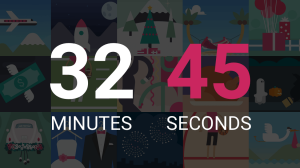
Live Countdown Timer With Animations
Countdown with colorful animations counting down the weeks, days, minutes, hours, and seconds...

Get the time at any given coordinate on Earth, calculate time zone conversions.

IMAGES
VIDEO
COMMENTS
London Transport Zones. London is divided into 1-9 zones*, but most of it fits into zones 1-6. Central London is zone 1, zone 2 is the ring around zone 1, zone 3 is the ring around 2 and so on. *zones 7,8 and 9 cover a small area just outside North West London including Watford, Croxley Green, Rickmansworth, Amersham or Chalfont & Latimer.
Ultra Low Emission Zone maps available to view and download ... Our live Tube map app helps you plan travel on the move. Walking maps. Whether you're walking for pleasure or purpose, see our maps and route descriptions. Audio maps. Audio maps available to download. Open up a free Footways map. Explore London's quiet and interesting streets with ...
The cost of a Zone 1-5 weekly Travelcard is £65.70 if you stay in Zone 5. A weekly Travelcard for Zones 2-5 costs £38.20, saving you £27.50 each week. To find out more information about oyster cards, head to our blog on the ultimate guide to oyster cards. 3.
Travelcards. A Travelcard (in the zones it's valid for) gives you unlimited travel at any time on bus, Tube, Tram, DLR, London Overground, Elizabeth line and National Rail services in London. You can use it on all buses, and if valid in zones 3, 4, 5 or 6, on all trams. Travelcards can start on any day.
london travel zone map legend. print london travel zones: free travel zone: travel zone 1: travel zone 2: travel zone 3: travel zone 4: travel zone 5: travel zone 6: travel zone 7: travel zone 8: travel zone 9
Covers Travelcards and Cap fares for Tube, DLR, London Overground, Elizabeth line and most National Rail services.
All of Greater London is within the six principal fare zones numbered 1 to 6. Inner zone 1 forms a roughly circular area and covers central London. Each of five outer zones forms a concentric ring around it. Zones 4, 5 and 6 additionally extend into parts of Essex, Hertfordshire and Surrey. List of boroughs in each zone:
The core of London, housing the majority of major attractions, falls within Zones 1-2. Suburban locales and renowned landmarks such as Wembley Stadium and the All England Lawn Tennis and Croquet Club in Wimbledon are encompassed by Zones 1-4. Zones 1-6 extend across almost the entirety of London, including Heathrow and London City airports.
Some of London´s most famous neighbourhoods are also located in zone 1, such as Notting Hill, Chelsea and Kensington. The most visited tourist attraction outside of zone 1 in London is probably Camden Market which is located in zone 2. To travel between zones 1 and 9 on public transport, including underground, overground, DLR, buses, trams and ...
It includes the London Zones 1-6 map and Zones 7-9 map. (London Zones 1 9 Map by Sameboat via Wikimedia Commons) (London Underground Zone 1 by Edg2s via Wikimedia Commons) ... If you plan to travel across Zones 1 to 6, here are some areas of interest to visit. You can make the most of the zones included in your card by traveling to the popular ...
The London Tube map [PDF 1.2 MB] makes navigating London's Underground rail network simple. This easy-to-use London Tube map shows all nine travel zones, including Zone 1, which covers central London. It also indicates stations with step-free access, riverboat services, trams, airports and more.
Travel time on the Tube is roughly 45 minutes to central London. Piccadilly line trains run out of Heathrow from 5:00 to 23:00. Ticket prices from Zone 1 to Heathrow are £6.70 for a cash-bought paper ticket, £5.60 on an Oyster card or contactless card at any time.
This map was created by a user. Learn how to create your own. This is a station accurate representation of the Transport for London Zone layout. Zone information taken from https://web.archive.org ...
London is the capital city of England and the United Kingdom, stretching an area of 1,572 km2.There are 32 boroughs in London, which requires an efficient transportation system. Thus, London is divided into different zones, namely 1-9 zones, but most fit into 1-6 London zones. Zone 1 is central London, and Zone 9 is the outskirts of London.
We would like to show you a description here but the site won't allow us.
Travel to and from Heathrow Airport — use your Travelcard for tube travel from Heathrow Airport into central London (with a Zone 1-6 Travelcard). Receive an exclusive 33% discount on the Thames Clippers River Bus services. Get a same-day-dispatch when ordering any weekday before 9:00 am (UK time).
Fare zone 6 is an outer zone of Transport for London's zonal fare system used for calculating the price of tickets for travel on the London Underground, London Overground, Docklands Light Railway, National Rail services (since 2007), and the Elizabeth line within Greater London.The zone was created in January 1991; previously it had formed part of zone 5 since May 1983.
The 'Zone' System Explained London is divided into circular 'zones' that surround the city. When it comes to getting around, London is divided into 'zones' 1-9, with 'Zone 1' being the city centre and 'Zone 9' being the outskirts of the city. The system itself exists as a method for TfL (Transport for London) to calculate a customer's travel distance and charge accordingly.
On Tube, DLR, London Overground, Elizabeth line and National Rail services in London: Peak fares - Monday to Friday (not on public holidays) between 06:30 and 09:30, and between 16:00 and 19:00. Off-peak fares - at all other times and if you travel from a station outside Zone 1 to a station in Zone 1 between 16:00 and 19:00, Monday to Friday.
Travel zone 1 - 6. I am having a bit of a brain freeze, I am coming to London staying in zone 6 for 5 days, for a few of the days I will be getting the train to the centre and back multiple times in the one day and using the buses in the centre. The Travelcard is capped at £15.20 off - peak and you get 30% off the boats, the Oystercard capped ...
There are several ways to get around London on a budget. The best way to save money is by taking public transportation such as the Tube, buses and overground trains. You can also rent a bike or ...
Europe's leading train and coach app. We help customers across Europe make more than 172,000 smarter journeys every day. Get a link. Travel by train from London to London Underground Zone 1-6 in 0m. Compare prices, view live journey times & book cheap train tickets for London to London Underground Zone 1-6.
How much it costs and how to pay to travel around London. Find out what's the best ticket for you and how to use contactless and Oyster cards, view fares, check if you can get a refund or replacement and see if you're eligible for free and discounted travel.
International travel is almost back to pre-pandemic levels, according to the just-released list of the world's busiest airports in 2023. 8.5 billion passengers traveled globally by plane last year ...
Time Zone Converter - Time Difference Calculator. Provides time zone conversions taking into account Daylight Saving Time (DST), local time zone and accepts present, past, or future dates. Time Zone Converter Meeting Planner.